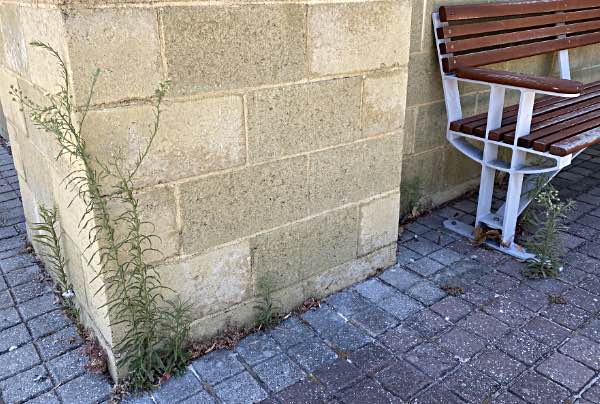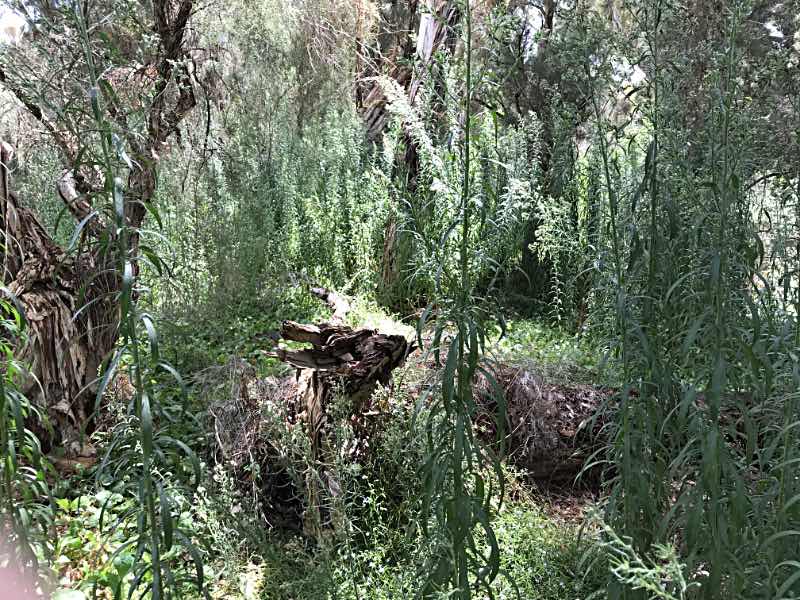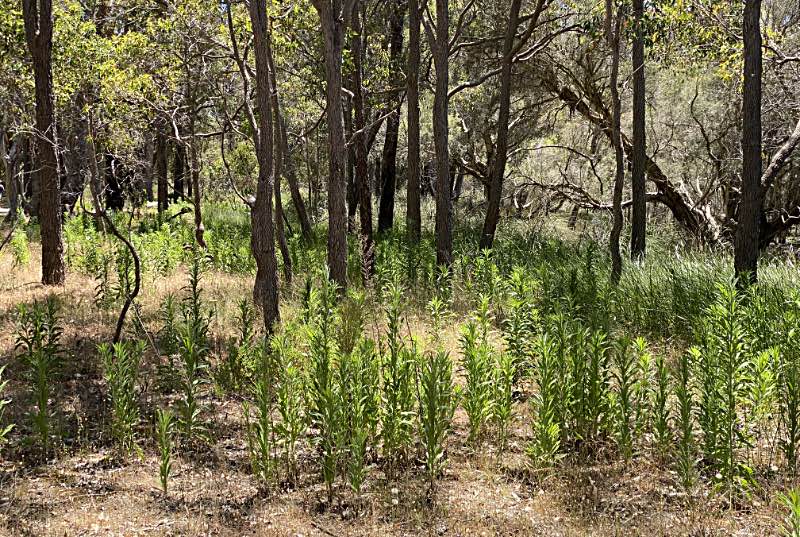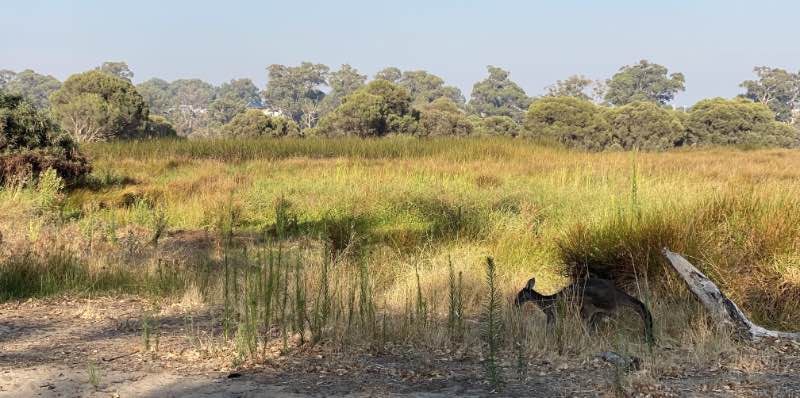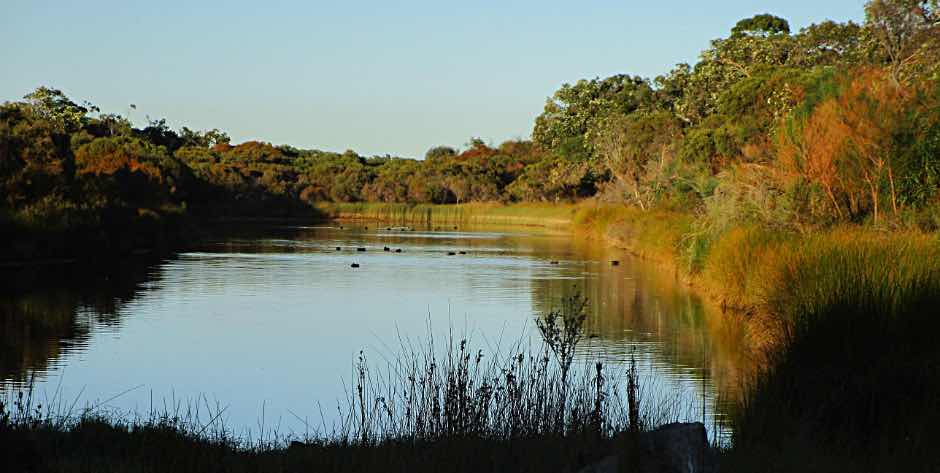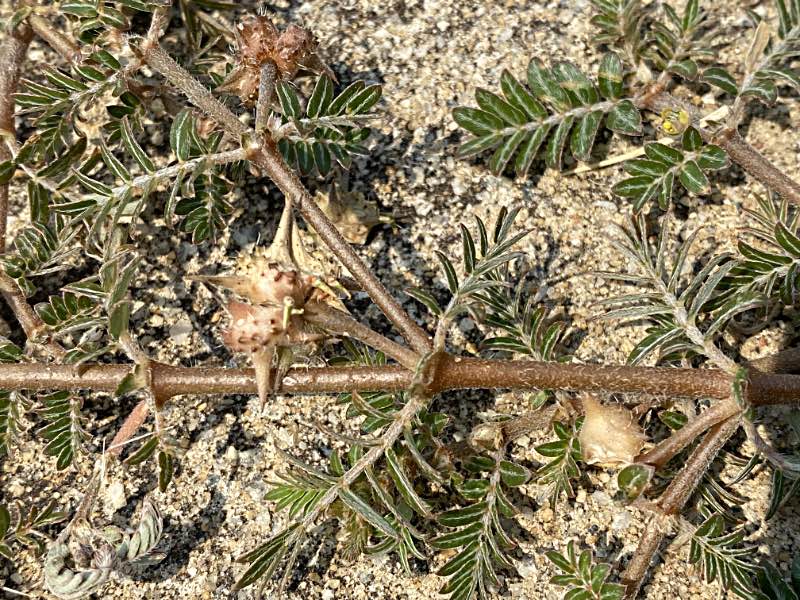| |
|
|
|---|

| This patch of fleabane was in the southern part of the big seasonal paperbark reserve. Note that it is on a slight mound; I suspect that the surrounding area is seasonally flooded and that this kills any fleabane seeds in the soil.
This patch, which is one of many but denser than most, was sprayed on 2023/01/05, the same day I took the photo.
| |
By late March 2022 I had pulled out most of the live plants along the shared path between the Novara boat ramp and the southern side of the big seasonal swamp.
As mentioned above, someone, presumably from the Mandurah City Council, had sprayed some of the fleabane in the big seasonal paperbark swamp area around 2022/03/20. It would have been better done a month or two earlier, before seed-set, but better late than never.
By June 2022 there were very few fleabane plants to be seen in, and on the paths adjacent to, the Len Howard Conservation Park within a kilometre of my home. I had been putting in some time removing what were numerous fleabane plants in the big paperbark swamp area.
| |
This section added
2022/10/27
|
|
From July I saw very few fleabane plants in the area that I had adopted. I concentrated on onion weed from then for the following few months.
Fleabane started to become conspicuous again in October 2022. By late October I had removed or killed most of the onion weed plants that I could find in my area - other than in the storm water sump ( SWS) and in the Big Seasonal Paperbark Swamp (BSPS). (I was yet to start on the WOGL reserve.)
I didn't start keeping any sort of detailed record of my work on fleabane until early October 2022.
- 7th October 2022, 83 fleabane, mostly on LHCP concrete footpath
| |
This section added
2022/11/02
|
|
- 26th, 37 in BSPS
- 27th, 214, northern end and eastern side of BSPS
- 3rd November 2022, 10 W side, 30 N end
| |
With only a little care fleabane plants can usually be pulled out with most of their roots. If the ground is unusually hard sometimes just the top pulls off.
When I pulled out significant numbers of plants that were setting seed I collected them up and put them in a bin or took them home, to stop the seed from having any chance to germinate.
Methods I've used to control fleabane are:
- Pulling out the Larger plants;
- Hoeing the smaller plants except where they are in such great number that this is impractical;
- Spraying with glyphosate where there are too many plants to make pulling out or hoeing viable.
|
| |
| |
Glyphosate
A woman came up to me when I was spraying fleabane plants and expressed her opinion of glyphosate with something like "that stuff should never be used, it's shockingly harmful". (I don't remember her exact words.)
I have written elsewhere on this page about the reliable research on glyphosate toxicity.
And I have written on other pages about my sources of information and where we should look for reliable information.
| |
- 5th, more fleabane pulled and/or hoed
- 8th, something like 50 plants pulled or dug out near NW corner of BSPS
- 17th, while working mainly on onion weed I dug out perhaps 30 fleabane plants at the northern end of the BSPS. There are a great many to be pulled or hoed out.
- 50 fleabane pulled out BSPS.
- 19th, sprayed about 200 very small fleabane plants beside the path in the morning, pulled out about 80 big plants in the afternoon, BSPS
- 20th to 26th; pulled out and hoed out several hundred plants in BSPS. At about this time I stopped trying to count the fleabane plants that I killed.
- 29th, sprayed hundreds of young fleabane plants over a 120m section of the path adjacent to Glendart Court
- 1st December 2022, 50 large fleabane pulled out, NE side of BSPS
- 3rd, about 50 plants pulled or hoed out and perhaps 200 sprayed with glyphosate, S end of BSPS.
- 4th, some fleabane pulled out of BSPS, N end. 15m outbreak of fleabane on Silverton adjacent LHCP and scattered fleabane adjacent path further east all sprayed.
- 7th, about 50 by path adjacent LHCP
- 8th, hundreds of fleabane plants sprayed adjacent to Glendart Court and also Len Howard Drive
- 10th and 12th, fleabane sprayed at the northern end of BSPS, and a small patch beside the path adjacent to Dampier Avenue.
- 13th, several hundred plants sprayed, BSPS mid NE;
- 14th, 46 pulled out on Dampier
- 16th, sprayed around W/S reserve
- 17th, sprayed large infestation inside inner path, BSPS. Problematic because there are also ?native plants. This was one of the very few places where I had found a risk of off-target killing in spraying fleabane. Hoed and pulled fb on Silverton and Len Howard Drive;
- 19th and 20th, hoed and hand pulled fleabane adjacent to Len Howard Drive, Silverton Crescent and Glendart Court
- 21st, sprayed along the northern half of the path on the eastern side of the BSPS
- 22nd, sprayed and hand pulled on the northern side of the path across the southern end of BSPS
- 23rd, sprayed a patch at the NE corner of BSPS and some scattered plants
- 24th, hoed and hand pulled scattered plants N end BSPS and a patch inside the path in the NW area of the BSPS
- 25th, pulled and hoed fb N end BSPS inside paths
- 26th, sprayed fb in same area
- 28th, pulled and hoed fb on Len Howard Drive near BSPS
- 29th, spayed fb west side BSPS, mainly adjacent road. Hand pulled a patch adjacent Dampier.
| |
A patch of young fleabane plants in the BSPS
|
|---|
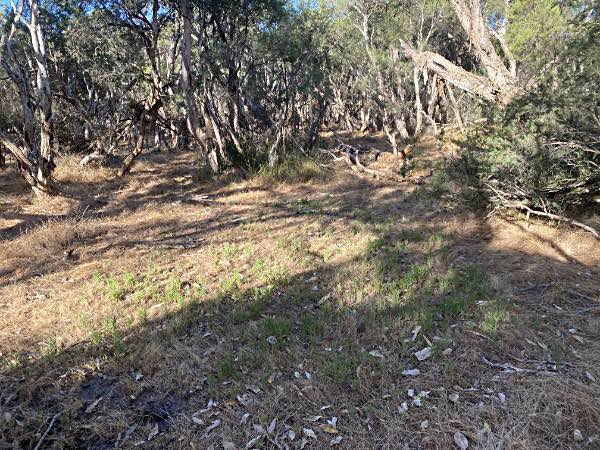
| Before hoeing
While many of the fleabane plants I've come across have been scattered there has also been a number of 'clumps' of plants such as the above. In some cases I have sprayed such clumps with glyphosate, at other times I've just used a hoe.
|
| |
| |
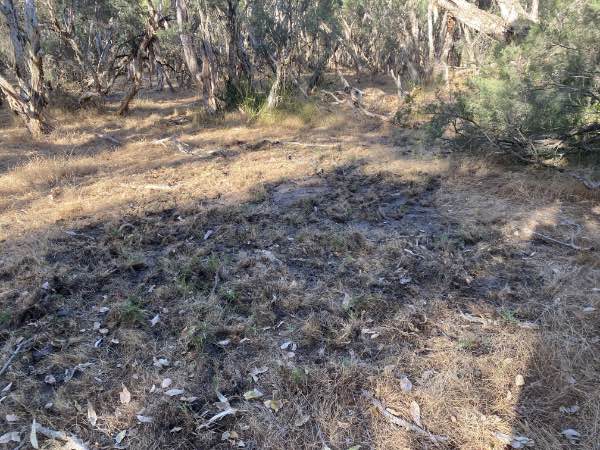
| The same patch as above, after hoeing
Photos: iPhone 11 pro, standard lens, 2023/01/17
|
|
- 20th, sprayed fb east side of BSPS, inside path. Hand pulled several hundred plants adjacent LHCP dirt path near back gate to Bridgewater Village. There were many small seedlings with lots mixed in with rushes - so I certainly didn't get them all.
- 25th, pulled and hoed N end BSPS inside paths
- 26th, sprayed fb in same area. 213 ow, N end, between paths
- 29th, spayed fb west side BSPS, mainly adjacent road. Hand pulled a patch adjacent Dampier.
- 31st, 210, ow S and N of BSPS. Hoed fb SW side ofBSPS.
- January 2023 (Fleabane progress continued) 1st, pulled fb in BSPS
- 2nd, sprayed fb, in extreme NW corner BSPS
- 3rd, sprayed fb in bush area, in from the NW corner BSPS
- 5th, sprayed fb in lightly bushed area inside southern path BSPS. Ran out of spray, will have to clean up remainder later.
- 7th, Pulled and hoed fb while hoeing onion weed
- 8th, pulled and hoed fb around the NE corner of the BSPS
- 9th, pulled out and hoed around NE corner of BSPS. Also planted Acacia saligna and hardenbergia comptoniana seeds
- 10th, 100 or so pulled or dug out of W/S reserve
- 11th, hoeing E side BSPS, W/S reserve
- 12th, hoeing E side BSPS, seeding and hoeing W/S reserve
- 13th, 100 minutes hoeing and pulling on BSPS.
- 14th, sprayed plants in among branches of fallen tree, one hour hoeing and pulling around eastern and northern sides of BSPS
- 15th, 1hr fb, N end BSPS. 1hr loop trail in LHCP
- 16th, 15min near home, 35min cleaning up remains of big patch among scrub sprayed in S end BSPS
- 17th, sprayed fb on loop path and adjacent road to car park in LHCP. 20 minutes hoeing in BSPS SW side
- 18th, 50 minutes hoeing and pulling fb among trees in BSPS
- 19th, 40 minutes hoeing and pulling among trees in W side of BSPS
- 20th, 70 minutes mainly hoeing, N end of BSPS
- 21st, 40 minutes hoeing and pulling among trees on E side of BSPS
- 22nd, 45 minutes, E side and S end BSPS, and seeding. Anyone walking on the paths around the BSPS would now see very little fleabane. Hand pulled fb adjacent paths in LHCP.
- 23rd, 75 minutes, NW and SE corners BSPS
- 25th, 55 minutes, N end BSPS
- 26th, 60 minutes, scattered NW corner BSPS.
- 27th, 30 minutes fb, W side BSPS
- 28th, spraying W side BSPS, in scrub
- 30th, pulling and hoeing, E side of BSPS, including the lawned area
- 31st, 20 minutes, pulling and hoeing, E side of BSPS, scattered plants
- 2nd February 2023, morning, 40 minutes, pulling and hoeing, SW corner of BSPS among trees, one fair sized patch plus scattered. Evening, 30 minutes N end BSPS within ~40m of paths. On many days I pull out isolated fb plants whenever I happen to come across them.
- 7th, hoed and pulled several hundred fb, in scrub, SW corner BSPS
- 10th, sprayed 500 or more plants in scrub, western side BSPS - they were too numerous to hoe or pull.
- 11th, 480 NW corner BSPS. Estimated more than a thousand remain - photo of a few
- 13th, sprayed one or two thousand plants, NW area of scrub in BSPS
- 14th, pm, over 200 hoed SW section BSPS in scrub. Of the many plants remaining I will have to wait to see which die due to being sprayed.
- 15th, pulled out about 100 plants beside storm water sump (SWS; while picking up rubbish)
- 17th, am, pulled out 20 or so plants while having a short inspection walk in BSPS; pm hoed and pulled over 100, NE corner of BSPS
- 18th, couple hundred hoed out, N end BSPS
|
|
|---|
| Outbreak removed - only about 40 minutes work
|
|---|
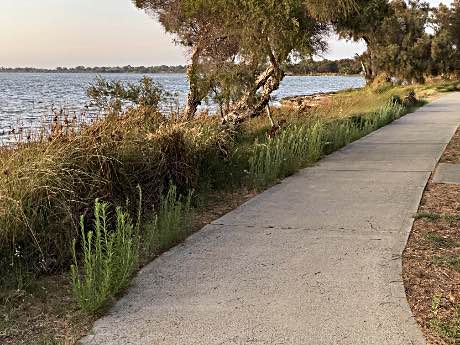
|
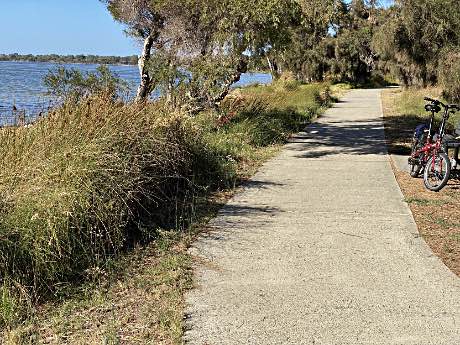
|
While the Novara Beach Reserve is well over a kilometre from my home it is a beautiful place in which I can have a significant impact on weeds with a moderate effort.
This is the same outbreak as mentioned elsewhere on this page and in regard to the backward steps of over-clearing path edges. On another page I've shown how ideal fleabane seedbeds have been provided in Black Swan Lake Reserve. Weeds are very good at colonising bared ground.
This outbreak was in the northern end of the Novara Beach Reserve. The reserve had very little other fleabane - it would have been a great pity if this patch had been allowed to go to seed again in 2023.
Photo and plant removal 2023/02/19.
|
- 19th, several hundred pulled out beside path at northern end of Novara Beach Reserve (outside of my normal area, but very important to be done to stop this dense area from going to seed - there were very few outside of this infestation)
- 20th, pulled out several hundred plants from the foreshore strip south of the Novara boat ramp into the northern half of the Novara Beach Reserve
- 22nd, sprayed in among the trees, NW area of BSPS. Pulled another hundred or so plants in the area from the Novara boat ramp to Novara Beach Reserve.
- 24th, pulled 87 scattered plants in grassed area E side of BSPS
- 25th, hoed and pulled about 340 scattered plants E side of BSPS
- 26th, hoed and pulled a couple of hundred on the E side of BSPS. I noticed that someone had been spaying fb using red marker dye.
| |
Dense fleabane patch against paving
|
|---|
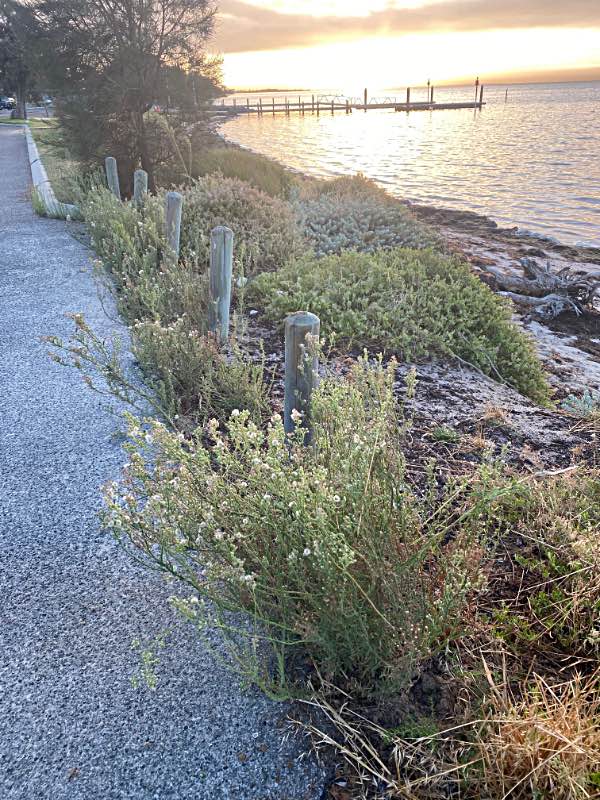
| Adjacent the lagoon in the southern end of Novara boat ramp car park area.
There were several areas where there were many fleabane plants but in most of the vegetated areas there were few or no fb plants; so it made sense to remove them all.
Fleabane often grows immediately adjacent to a paved area. I suspect that the seeds blow along the ground until they come to the edge of the paving, come to rest there and later germinate.
Photo iPhone 11 pro, standard lens, 2023/03/09 | |
- 1st March 2023 (Fleabane progress continued); hoed in the northern end of the BSPS
- 2nd, hoed in the northern end of the BSPS
- 4th, hoed and pulled scattered plants around the BSPS and pulled about 50 from the walking trail in the Len Howard CP
- 5th, about 50 pulled out at Osprey Waters Foreshore Reserve
- 6th, about 30 pulled out in and adjacent to the WOGL reserve
- 7th, one or two hundred hoed out in SW area of BSPS
- 8th, a couple of hundred from path sides Novara Beach Reserve
- 9th, several hundred sprayed (where too crowded to pull), several hundred pulled and binned (they had gone to seed, they came close to filling the bin), all at the western end of the Novara boat ramp car park (photo on right). In pm pulled out some fb and caltrop plants while picking up rubbish in the WOGL reserve and SWS.
- 10th, pulled out about 20 against Old Coast Road, WOGL reserve. About 50 in BSPS in pm.
- 11th, pulled out 57 northern end BSPS, about 20 adjacent Dampier Avenue and Dampier Court
- 12th, pulled or hoed about 30 in BSPS and about 15 around SWS
- 14th, about 50 plants WOGL reserve and adjacent SWS
- 16th, about 250 hoed and pulled out BSPS
- 21st, morning, about 40 hoed and pulled in scrub in BSPS. Afternoon, pulled out about 50 big plants in the Novara Foreshore Reserve. I was surprised I had not noticed them previously.
- 23rd, hoed out several hundred scattered plants in the scrub on the western side of BSPS. I hoed out all I saw.
- 25th, hoed and pulled about 100 near Novara boat ramp
- 26th, pulled out 2, SWS
- 28th, pulled about 6, SWS
- 29th, about 20 from W/S Reserve
- 30th, 20 from Novara Beach Reserve, 30 from bush inside BSPS
- 31st, about 10 on path adjacent LHCP
- April 2023 1st, near path on E side of BSPS
- 2nd, at least 200 pulled out at Osprey Waters
- 3rd, about 100 pulled out at Osprey Waters Reserve, all yesterday's and today's that had gone to seed binned.
- 4th couple hundred BSPS, scattered
- 11th, scattered BSPS, 15 LHCP, various elsewhere
- 12th, scattered plants various places
- 13th, a few scattered around W/S reserve
- 14th, about 40 N end BSPS
- 24th some W/S reserve, more than a hundred BSPS
- 26th, a very few scattered plants Glendart and Novara
- 28th, about 30, Novara Foreshore Reserve
- 30th, about 30, Osprey Waters Reserve, perhaps 20 adjacent the trail in LHCP
- May, 2023 3rd, scattered, path adjacent LHCP, W/S reserve
- From 4th to 9th I hoed or pulled out small numbers of plants in many locations in my area of activity.
- 12th, pulled out 225 plants in Novara Beach Reserve
- 19th, about 30 BSPS
- 20th, scattered plants hoed in BSPS
- 25th, pulled out about 30 plants at the western end of the Novara boat ramp car park
- 30th, about 25, BSPS
- June 2023 (Fleabane progress continued) 1st, A dense patch of several hundred plants, eastern side of BSPS, nearer the scrub than the path. 20 or so elsewhere in BSPS.
- 8th, about 30, N end BSPS
- 15th, about 10 N end BSPS
- 24th, 10 scattered in BSPS
- 29th, About 50 scattered about in BSPS
- 1st July, around 500 hand pulled from a fairly confined area near the playground in Osprey Waters Reserve
- From July to mid September 2023 I continued to pull out, or hoe out, fleabane plants whenever I saw them but I didn't see many and all were small.
- 30th September, about 50 plants scattered about BSPS. I am seeing fairly large plants at this time.
- 10th October 2023, 12 large plants eastern side of BSPS
- 13th, 46, mostly SE of BSPS
- 26th, 121 East side of BSPS. I had pulled scattered plants in the past weeks.
- 26th, 121 E side BSPS
- 28th, about 50 plants, N end BSPS
- 31st, about 6 S end of BSPS
| |
|
|
|---|
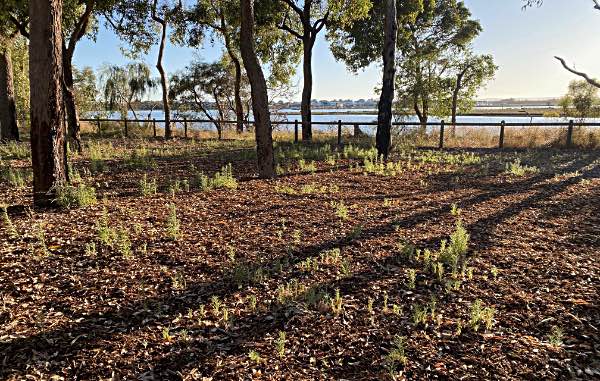
| Photo iPhone 11 Pro, 2023/11/18
At my request council took care of this outbreak.
| |
- 6th November 2023 (Fleabane progress continued), about 40 E side BSPS
- 8th, 276 N and E of BSPS. 40 Len Howard drive adjacent LHCP
- 14th, about 50 sprayed road edge adjacent LHCP
- 15th, several hundred, S end BSPS
- 17th, E side and NE corner BSPS
- 18th, I pulled out at least a thousand in Osprey Waters Foreshore Reserve in the same area that I cleaned up in April 2023. That was less than half of them. (Photo on the right)
- 19th Osprey waters, I hoed our another thousand or more; decided there were more than I could handle; informed Council
- 20th, 21st, E side BSPS, more than a thousand each day outside of the path. I don't think I had previously removed weeds from outside the path on the eastern side of the BSPS.
- 22nd, another thousand or so on the east side of BSPS, mostly outside of the path.
- 23rd, about 500 east side of BSPS. That was all I could find at the time.
- 24th, about 100 N end BSPS
- 25th, about 500 in scrub W side BSPS
| |
|
|
|---|
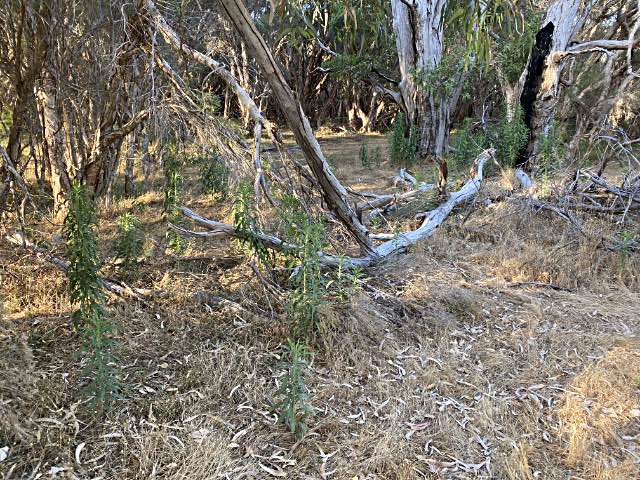
|
This outbreak was far enough from the path to be easily passed by without seeing, it was among the trees in the NE part of the BSPS, Len Howard Conservation Park.
This gives a hint of how bad fleabane could be in the LHCP if it was unchecked (as in similar reserves elsewhere).
Photo, iPhone 11 Pro, standard lens, 2023/12/09
|
| |
| |
Getting on top of them!
In mid December 2023 I'm convinced that I'm getting control over both onion weed and fleabane in all my high priority areas. There were times when I had doubts that I would.
|
| |
| |
In late November 2023 I contacted Mandurah Council telling them of the big outbreak of fleabane in Osprey Waters Foreshore Reserve. Some days later I had a reply thanking me for reporting it and saying that they had fixed it. I had a look on 2023/12/18 and it appeared as if the fleabane plants were dying.
|
|
- 27th, about 50 N end BSPS
- 28th, uncounted plants, N end BSPS
- 29th, several hundred NE corner of BSPS
- 30th, several hundred N and NW of BSPS
- 1st December 2023 (Fleabane progress continued) Many scattered plants S and E side BSPS
- 2nd, plants removed SE corner BSPS
- 4th, scattered, N end BSPS
- 5th, several hundred, NW corner BSPS
- 6th, big patch sprayed and several hundred hoed adjacent road SE corner BSPS
- 7th, a big patch and many other plants hoed, edge of scrub, N end BSPS
- 8th, scattered plants N end BSPS
- 9th, scattered plants and a couple of colonies and the patch of big plants in the photo, N end BSPS
- 10th, E side BSPS
- 11th, E side BSPS
- 12th, widely scattered through W and N of BSPS
- 14th, scattered plants in W/S reserve
- 15th, about 500 plants scattered around BSPS
- 16th, scattered plants in several reserves and beside paths
- 18th, about 15 Novara foreshore reserve, 30 SWS
- 22nd, hoed many hundred more in area previously attacked, eastern side of BSPS, outside of path
- 24th, hoed several thousand in and near a storm water sump and extreme E side of BSPS
- 25th, a thousand or so E side BSPS, most outside of path
- 26th, over a thousand BSPS area
- 27th, scattered plants E, W and S parts of BSPS, quite a few inside the treed area. I walked most of the areas where I thought I might find fleabane. More time looking than digging. Also about 40 plants in Novara Beach Reserve.
- 28th, a few plants W/S reserve. All I could find there and SWS and WOGL reserves.
- 30th, 50 or so pulled out Osprey Waters Reserve. I need to go back and finish the job, and tidy up the area that Council had sprayed.
- 31st, 3/4 hour hoeing fleabane near the playground at Osprey Waters
| |
Numbers of fleabane plants destroyed
|
|---|
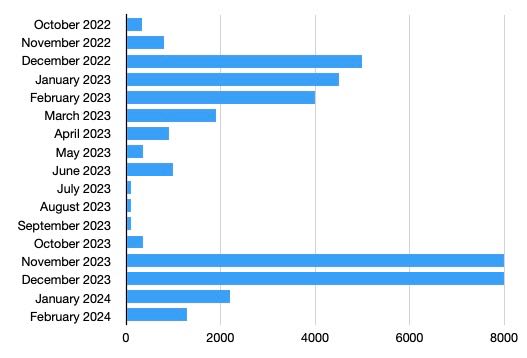
| An approximation of the monthly totals recorded in the text up to 22nd February 2024.
The greatest numbers of those removed in late 2023 and early 2024 were from areas I had not previously worked.
Although fleabane plants can live more than one year it is primarily an annual plant.
| |
- 2nd January 2024 (Fleabane progress continued), scattered plants N end BSPS
- 4th, more than 500 plants on NE corner and eastern side of BSPS, both inside and outside of the path
- 5th many inside and outside path E side BSPS. All I could find in the area.
- 6th several hundred. Walked right around BSPS, mostly inside trees.
- 8th, cleaned up missed fb on E side BSPS mostly outside of path.
- 11th, couple hundred plants NW boundary area of BSPS
- 12th, 50 or so fb adjacent Bridgewater Lifestyle Village in BSPS. (Took photos of fb on BLV side of road.)
- 16th about 300 sprayed at the foot of retaining wall parallel to Flinders St and boat trailer parking area.
- 20th, about 20, BSPS
- 26th, 30 on LHCP trail, 40 W side BSPS
- 27th, 3-400, on walking right around BSPS near the tree line
- 31st, about 30 near boat ramp
- 1st February 2024, about 10 found N end and E side BSPS
- 3rd, a dozen or so adjacent path on Glendart Court
- 4th a hundred or so, many large, between Perseverance Boulevard and caravan park Novara foreshore. A thousand or so very small at foot of retaining wall parallel to flinders St.
- 11th, about 40, Novara beach reserve
- 17th 135 from path around BSPS
- 25th 75 BSPS
- 26th, 269 E side BSPS
- 27th, over 500 in small storm water sump NE corner BSPS
- 28th, 63 inside paths and tree line, right around BSPS
- 1st March 2024, 44, Novara beach reserve
- 4th 125, around BSPS, outer area.
- 9th, about 20 big flowering plants near Novara boat ramp, binned
- 10th, 622, osprey waters reserve
- 13th, about 800, BSPS. 100 of these were scattered individuals or groups of a very few plants, the remainder were in three small patches of only a few square metres each. All were inside the tree-line. The patches were on the eastern side of BSPS
- 21st, 218, mostly E side BSPS. Inside tree line
- 27th, 48 BSPS, among trees
- 28th, 122 mainly inside path, near tree line BSPS
- 30th. Pulled 100 from base of wall SE of Flinders St. Ten beside path Novara Beach reserve.
- 31st, about 500 at base of wall SE of Flinders Street.
- 6th April 2024 (Fleabane progress continued) I went right around BSPS, 274, most in storm water sump sump in NE corner
Also see the fleabane and dune onion weed sections, and the section on progress with the control of onion weed, on this page.
| |
This section added
2022/03/28
|
|
The section of the walking trail that is the subject of this note, and a small part of which is in the photo, is to the north of the big seasonal swamp and to the south of Mandurah Quay. The native vegetation on each side had been cut back heavily shortly before my wife and I walked it on 2022/03/28.
Opportunistic weeds - like fleabane, evening primrose and onion weed - will take full advantage of any bared ground. Excessive clearing of native vegetation, like this, is bound to give weeds a foothold.
Several hundred metres of the path were like this. In this section native sedges or rushes can be seen to have been heavily cut back to the left of the path, but the whole visible section, and far more, had been cleared for half a metre or more on each side of the path.
I suspect the intention of whoever did the clearing was to allow people to see any snakes that may be present. I've seen several snakes in or near the Len Howard Conservation Park, but they seem to be easily avoided. Surely the preservation of the native bush is more important than protecting people from the occasional close encounter with a snake.
I've dug out onion weed that has similarly invaded cleared path margins near one of the Mandurah giants. A good example of how quickly onion weed can invade an area is in the local environment surrounding Santi Ikto giant, Halls Head. The weed was well established only a year after the official opening of the giants.
In early May 2023 I noticed that trees near the trail through the western section of the Len Howard Conservation Park had been very recently trimmed back to widen the trail. This would make it easier and more convenient for users, but again, at a cost to the remnant vegetation. Again, people have been put first, the environment second.
I have argued elsewhere, that if humanity is to have a future we must learn to put the environment first. We are nothing without a viable environment.
I have written about a similar widening of a different part of the LHCP paths at another time under Widening of the paths on another page on this site.
This all reminded me of when the Port Pirie Regional Council excessively and unnecessarily cut back remnant native vegetation on the roadsides near my old home.
| |
This section added
2023/02/22
|
|
In the beginning I intended to try to remove all the fleabane in and adjacent to parks within about a kilometre of my home in Erskine. A little later I added the removal of false onion weed to fleabane. Later again I extended the area I worked on beyond a kilometre.
In general, the area I'm working on is all the parks and path borders adjacent to parks within a few kilometres of my home - with the notable exception of the area within the Len Howard Conservation Park to the east of the Big Seasonal Paperbark Swamp. I'm giving the highest priority to those parks that have the most visitation by the public.
I'm not working on the section of the LHCP to the east of the BSPS because the infestation there is particularly bad and it is quite a way from my home.
Definable areas I was working on by mid 2023 included - in approximate order of increasing distance from my home:
- The small unnamed reserve at the western junction of Wattleglen and Silverton (W/S Reserve)
Scattered fleabane and particularly onion weed. Its area is about 7,000 square metres. As of the end of March 2023 I had dug out over 2000 onion weeds plants from this reserve.
- Part of the Len Howard Conservation Park (LHCP)
Used frequently by walkers. There was a bad outbreak of onion weed at the car park, particularly around the information sign, and there was scattered fleabane and onion weed in many other places, including along the path adjacent to Len Howard Drive and Silverton Crescent. The part that I am trying to look after is to the west of the BSPS . The area of 'my' section is about 37 hectares, but much of it is inaccessible. As of the end of March 2023 I had dug out over 800 onion weeds plants from this reserve, most of them in the car park area.
- The car park within the LHCP, toward the western end and near the Nature's Eye shelter. I have listed this as a specific area because it was particularly infested with onion weed. A Google Earth image on this page includes the car park.
| |
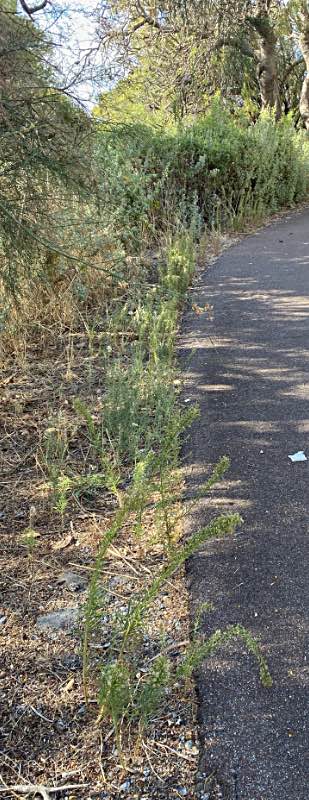
| A section of one of only a couple of patches of bad fleabane outbreaks in the Osprey Waters reserve.
| |
- The storm water sump reserve on Wattleglen Avenue (SWS)
Given a low priority because it is not used by the public, but heavily infested with onion weed. Its area is about 11,000 square metres. As of the end of March 2023 I had dug out about 900 onion weeds plants from this reserve.
I had also sprayed some onion weeds and wiped others with glyphosate.
- WOGL Reserve: The small unnamed reserve between Wattleglen Avenue, Old Coast Road, Galbraith Loop and Lloyd Crescent was added to my list on 2023/03/05, because it was in fairly good condition, with fairly few weeds and not far from my home. The area is about 5,400 square metres. I have not given it a high priority because it seems to be not much used, probably because it is so close to the very busy, and noisy, Old Coast Road. As of the end of March 2023 I had dug out over 500 onion weeds plants from this reserve. I was still finding more at the end of June.
- Novara Foreshore Reserve;
Around the Novara boat ramp and along the lagoon to the northeast from there; a very popular and well maintained reserve with walkers and bicyclists. It had relatively few weeds and rubbish, I will try to keep it that way.
- The Big seasonal paperbark swamp (BSPS) on the eastern side of the Bridgewater Lifestyle Village, between Len Howard Drive, Oakleigh Drive and Chatswood Drive. Part of this is the responsibility of the Parks and Wildlife Service and part the responsibility of Council, as shown in my section on the Responsible Authorities for the BSPS on this page.
This reserve is very popular with walkers and bicyclists. It had an enormous number of both fleabane and onion weed plants - certainly by far my greatest challenge. Most of the fleabane has been in the part that is Parks and Wildlife responsibility, almost all of the onion weeds have been in the section that is Council responsibility. Its area is about 20 hectares (200,000 square metres). As of the end of March 2023 I had dug out over 15,000 onion weeds plants from this reserve.
I had thought of planting more trees and/or shrubs in the BSPS from early on, but was discouraged by a Parks and Wildlife Service representative who said, reasonably, if I plant then others may start planting and who knows what they will plant. However I did get permission to plant marri trees from Council in their section of the park. I started with the first four seedlings on 2023/07/02 and planted another seven a few days later. By September about half had disappeared, probably eaten by kangaroos.
- Novara Beach Reserve
A beautiful, generally well tended reserve, very popular with walkers and bicyclists, well over a kilometre from my home.
Apart from a single dense outbreak it contained only scattered fleabane plants and very few onion weeds when I started on it in February 2023. I added it to my project area because I could have a significant impact with relatively little work.
| |
A few of the onion weeds at Mandurah Quay
|
|---|
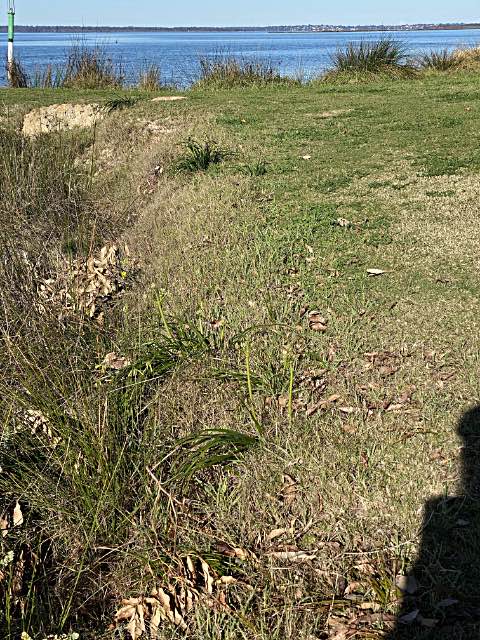
| |
- Osprey Waters Foreshore Reserve
While this area is about four kilometres from my home and therefore outside of my main work area I found only a few hundred fleabane plants when I started on it (in April 2023). It is a beautiful park, used frequently by walkers, and well worth looking after.
On 2023/11/18 I happened to be passing by when I noticed a major outbreak in Osprey Waters. I estimated that I pulled out at least a thousand that morning and that was less than half of those present.
I later found fleabane in the Osprey Waters playground. As of the beginning of 2024 Osprey Waters is one area in which fleabane is not under control.
- Mandurah Quay
In early August 2023 I noticed a number of false onion weed plants close to the waterfront on the eastern side of the Mandurah Quay inlet (see photo on the right). They were scattered over a length of coast of several hundred metres. Later in the same month I wiped them and several hundred others in the same area with a strong glyphosate solution.
I hoed out more than 200 onion weeds from this area in October 2023.
| |
This section added
2022/04/30
|
|
| |
The reserve, W/S Reserve
|
|---|
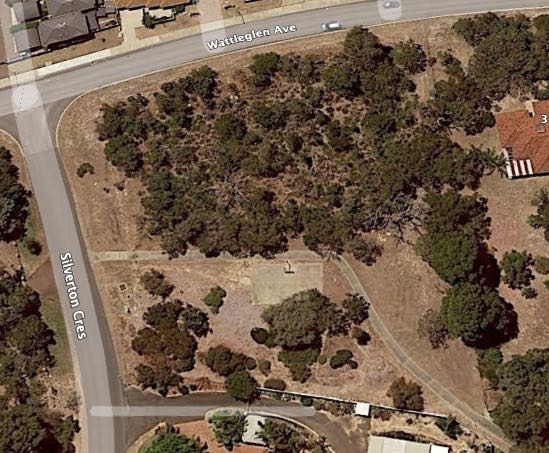
|
I intend to keep the whole of the area of this reserve free of fleabane and onion weed.
There was a fire in this reserve on 2023/11/15 about which I have written on another page on this site.
|
| |
| |
|
|
|---|

| Pigface ( Carpobrotus glaucescens?) flowering near the Gleeson Wetlands centre shelter shed, 2018/10/15.
This will provide some year-round greenery and give some very attractive colour when flowering along the sides of the path.
| |
There is a small reserve area at the western junction of Silverton Crescent and Wattleglen Avenue that has been somewhat neglected. I have started planting shrubs and trees obtained from Men of the Trees, Mandurah branch there and intend to do much more, in consultation with Mandurah Council.
I have also planted small shrubs along the sides of the public walking/cycling path that leads off to the Southeast of the reserve.
On 2022/05/03 I sprayed all the onion weeds I could see with glyphosate. At that time I counted about 95 pigface plants along the shared path and another 20 in the little reserve. Since then I have continued to remove onion weed (as recorded in progress on onion weed) as well as fleabane.
Seedlings that I have planted in the reserve include:
- Anigozanthos species (kangaroo paw)
- Callistemon viminalis (Little John)
- Carpobrotus species
- Chorizema cordatum
- Conostylis acuteata
- Eremophila bicerrata
- Eremophila glabra
- Eucalyptus erythrocorys
- Eucalyptus gomphocephala (tuart)
- Eucalyptus macrocarpa (mottlecah)
- Grevillia preissii
- Hakea laurina
- Hakea Maria
- Hakea trifurata
- Hardenbergia comptoniana
- Hemiandra pungens (snakebush)
- Hibbertia grossulariifolia
- Kunzea baxteri
- Melaleuca lateritata
- Melaleuca nesophila
Most of the above have since died.
Seedlings that I have planted by the path include:
- Anigozanthos species
- Beaufortia oestiva
- Dianella revoluta
- Goodinia varia
- Hakea varia
- Tempeltonia regusa (cocky's tongue, red and yellow)
- Thrytomene baeckeacea
All the above have been obtained from Men of the Trees, Peel branch. This is by far the best source of native plants that I have found in or near Mandurah, and their prices are ridiculously low. I believe that they have a sale every Sunday morning from 9-11am from late Autumn right through Winter and well into Spring.
Bunnings have plants for sale, but most are not Australian natives, the range of natives they have is small, and their prices are quite high.
Also see the note on my disagreement with Mandurah Council over this project elsewhere on this page.
About ten tree guards were kicked around on 2022/07/07. Only one tree seems to have been damaged. It is pleasing that there had been no vandalism previously. Of course it is to be hoped that this will be a one-off.
Of course there is vandalism in Mandurah, as there is throughout Australia.
In my efforts to revegetate the long neglected land of Crystal Brook's Central Park I had much worse vandalism than this, at one time a vandal pulled out more than a hundred young trees. I went on and I believe that park is still doing well with more than 500 trees and shrubs that a few friends and I planted and looked after.
| |
This section added
2022/10/27
|
|
One of the few unfenced storm water drainage pits in the Mandurah area is on the south side of Wattleglen Avenue close to its western intersection with the Old Coast Road. For this page I've abbreviated its name to SWS (storm water sump).
The sump/pit is surrounded by native bush but the outer parts have been badly invaded by dune onion weed. At the time of writing this section I had sprayed a number of the plants with roundup on two occasions. I became more serious in removing the onion weed in mid March 2023, when I felt I had other areas under some level of control.
It is an area where there is a lot of dumping of rubbish, which I pick up from time to time.
| |
This section added
2022/05/22
|
|
| |
Onion weed hoed out
|
|---|
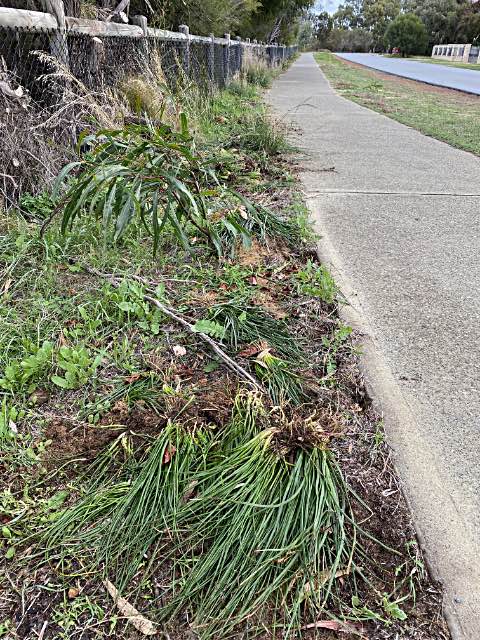
| On a part of the path running alongside the Len Howard Conservation Park, 2022/06/13
About this weed
This perennial herb is a native of South Africa and is now widespread on the Swan Coastal Plain especially in coastal heathland in white and grey sand. It is similar to Onion Weed Asphodelus fistulosus in appearance but has flat leaves and the flowering stalks [are] widely branched.
Description
A rhizomatous, perennial herb growing to 0.35 m high. The plant produces tall flowering stalks with small white flowers in spring.
Impact on Bushland
A major weed of coastal dunes and is spreading inland. Fleshy leaves are able to spread over the sand surface and may be up to 1 m long, making older plants competitive for space. Has variable fruit set, affected by the age of plants and weather conditions. Has adaptions for dispersal by wind and water. Wind dislodges and carries crowns of mature inflorescences acting as a tumbleweed, spreading numerous small seeds. Germination is inhibited by light, a response to blowing sand habitats where germination on the dry surface could prove detrimental. Poisonous to mammals.
|
| |
| |
Mandurah City Council
I think it was 9th August when a council employee I met at the big seasonal paperbark swamp told me that council would spray the heavy onion weed infestations adjacent to Oakleigh Drive at the northern end of the swamp.
By 18th August there was no indication of council weed control so I decided to hoe out those onion weed plants that were starting to flower; plainly it was important to not allow them to set seed.
Parks and Wildlife Service
On 17th August a P&WS employee I met at the Len Howard Conservation Park car park by the lagoon and 'Nature's Eye' shelter told me that they would be spraying weeds in the area on the 18th. I don't think they would find many onion weeds or fleabane because I've got most of them. On the other hand, I will be very interested to see if there is any control of the very heavy infestation of onion weed in the area of LHCP north of my area of operation.
Update 2022/09/14
Someone, presumably the council, have scraped bare a strip of ground adjacent to Oakleigh Drive on the north side of the BSPS. This has at least stopped some onion weed from flowering, but whether it will help in controlling the infestation remains to be seen (it may spread the bulbuls over a larger area).
I have seen no indication that either council or PWS have done any work toward controlling the local onion weed which was well on the way to setting seed.
|
| |
| |
Mass of bulbul-based false onion weed plants
|
|---|

| The great majority of these tiny plants with attached bulbuls were within a couple of centimetres of the path. I hadn't seen anywhere near so many massed together in such a small area anywhere else.
By early November most of the onion weeds in the area I was targeting were small plants such as these, with only a very few leaves each. There were very few of the larger clumps, such as in the earlier photos, remaining.
Photo iPhone 11 Pro, standard lens, 2022/09/26 | |
Another bad invasive weed in addition to fleabane in the area is dune onion weed ( Trachyandra divaricata, other common names are false onion weed and strapweed). I started controlling this in the reserve at the western Silverton/Wattleglen junction in May and at that time had done a very little work on this weed elsewhere.
Spraying with glyphosate seemed to be effective, but took a very long time to kill the plants in winter.
By mid June I had started making a serious effort at removing onion weed in the small unnamed park and along the edge of the Len Howard Reserve.
Sometimes the plants can be successfully hand pulled but in most cases only the tops pull off leaving the roots and tuberous base in the ground. The most reliable way of control available to me seemed to be hoeing, so as to remove as much of the plant and its roots as possible. Sometimes the plants would re-root if dug up and left lying on moist ground. Shaking all soil off makes re-rooting less likely and re-rooting doesn't happen when the ground is dry.
Where they were large and numerous I usually heaped up the plants that I had hoed out. Placing dug up onion weeds on a log or something other than the soil also minimises the chance of re-rooting. Where there were very numerous very small plants all I could do was to hoe them and hope that most would die.
I've heard an opinion that digging out dune onion weed is ineffective. I can't imagine that the removal of the plants with the majority of their roots and bulbuls would be ineffective and I note that Urban Bushland Council WA Inc recommends "Manually remove isolated or small infestations prior to flowering. Wipe with 50% Glyphosate solution before flowering. Optimum time for removal – any month."
I have had moderate success spraying onion weed with glyphosate so long as the plants were actively growing at the time.
June 2022; By 2022/06/21 I had been seriously working at removing onion weed in the big seasonal paperbark swamp (BSPS) for a few days (I didn't start counting how many plants I hoed until 2nd July).
While there is a huge amount of onion weed adjacent to or in the LHCP east of the BSPS I have no intention of trying to remove onion weed further from home than the BSPS.
July 2022; By 2022/07/17 I had hoed out over 500 onion weeds in and adjacent to the park at the Wattleglen/Silverton intersection; all I could find to that point.
- On 2022/07/02 I hoed out about 270 onion weed plants in the northern end of the swamp area and estimated that there were over a thousand left.
- On 6th July I hoed out another 310 or so, and pulled out about 20 small fleabane plants.
- On 7th July another 230 onion weeds;
- 8th 320;
- 10th 106 (these were at the south end of big swamp, so far as I know they are now all removed from there);
- 11th 428 (a passer-by said "I think you're fighting a losing battle"; I will enjoy proving him wrong);
- 12th, 366 removed from the Silverton/Wattleglen (S/W) reserve;
- 13th, 203 from S/W reserve;
- 14th, 100 in the morning, N end paperbark swamp, adjacent to Oakleigh Drive;
- 15th, 112, N end;
- 16th, 210, N end;
- 17th, 131, from S/W reserve;
- 18th, 110 in the morning by the car park near Nature's Eye shelter on the edge of the Peel lagoon; within a very few metres of the Len Howard Conservation Park sign. Perhaps the densest patch I’ve seen, I went back later; couldn’t make any meaningful count, many hundreds in a small area. (I spoke to one employee of the Parks and Wildlife Service who I happened to meet there, and to his boss on the telephone at the same time. Both were pleased with what I was doing.)
- 19th, 152, lagoon car park again, further west. I dug out all that I could find in the car park area and heaped them up;
- 20th, big swamp 259, N end, hoed and heaped; 144 in SE and NE corners;
- 21st, 149, N end, about 30 fleabane;
- 22nd, 137, NE corner, about 15 fleabane;
- 23rd, 170, N end, a few fleabanes;
- 24th, 148, NE corner;
- 25th, 302, NW corner in am. 148 on the path to the Nature's Eye car park in pm; these were scattered plants that I had missed earlier;
- 26th, 236, NE corner;
- 29th, am, 242, N end; about 200 in pm adjacent path to car park and right adjacent the information sign in the car park. The latter is the densest patch I've seen anywhere. Whoever put the signs in must have brought gravel loaded with onion weed seed in at the same time;
- 30th, 510, N end. The most I've taken out in one session;
- 31st, 146, N end;
- 1st August 2022 (Onion weed progress continued), 152, N end;
- 2nd August - ... Temporary halt to removing onion weed from Council controlled land after being reprimanded for removing the weeds by a council ranger;
- 9th August, 117 onion weeds removed from the path bordering Len Howard Way and in the car park area near Nature's Eye shelter and 58 scattered plants at the N end of the swamp, inside the outer path;
- 10th, 550 NE corner of swamp, outside the outer path;
- 12th, 186 NE corner, plus a lot of previously dug out plants that were re-rooting;
- 13th, 145, N and S ends;
- 15th, 78, N and S ends, and rerooting plants;
- 17th, 20 from car park by lagoon, 150 from W/S reserve;
- 18th, 142, NW corner, mainly plants that were getting ready to flower;
- 19th, 220, N end, about half had rerooted;
- 20th, 170, NW corner, some of them starting to go to seed;
- 21st, 228, N end;
- 22nd, 313, NW corner;
- 23rd, 320, NW corner;
- 24th, sprayed onion weed around the storm water sump (SWS), Wattleglen Avenue. Glyphosate;
- 25th, 326, NW corner of swamp. Still overflowing;
- 8th September 2022 (Onion weed progress continued), 208, NW corner of the BSPS area, the swamp was till overflowing. The onion weed that I had sprayed at SWS was dead or dying;
- 15th, 231, N end;
- 16th, 164, NW corner;
- 17th, 266, N end;
- 19th, 250, N end;
- 20th, 30, adjacent LHCP path toward car park;
- 21st, 50 adjacent LHCP path toward car park; 151, BSPS N end;
- 22nd, 69, last of the plants at the northern end of the BSPS against Oakleigh Drive, the worst area with the most weeds. A milestone. Next up the area beside the northern end of Len Howard Drive. The swamp is still overflowing;
- 23rd, 231, N end Len Howard Drive;
- 24th, 153, ditto;
- 25th, 251, ditto;
- 26th, 231 in the morning, in afternoon 300 scattered, all N end;
- 27th, Sprayed the remaining massed plants bordering Len Howard Drive. All the onion weed I had intended to control has now been attacked at least once. Now I will follow up with the stragglers.
- 28th, I didn't remove any more onion weeds but noticed that the BSPS had stopped overflowing into the lagoon.
- 4th October 2022, 173 removed from adjacent to the path along Glendart court
- 5th, 324 removed, NE end BSPS, in and adjacent to scraped strip by Oakleigh. All I could find without searching
- 6th, 197, car park, by shelter sign. The sum of onion weed plants removed is now 12,500
- 7th, 19 N end
- 9th, 161, onion weeds beside footpath, Glendart
- 10th, 52, ditto
- 12th, 184, reserve behind our house; 75 BSPS, N end, inner path
- 13th, sprayed dense patches against N end of Len Howard Drive again
- 17th, 11, BSPS, N end
- 18th, 44, Glendart and car park. Water level in BSPS is falling quickly. (I found at least 12 kangaroos. They seem to be staying in the scrub more than they were.)
- 23rd, app. 200, last of massed onion weeds, NW corner of BSPS, adjacent LH Drive
- 26th, about 200 onion weed in W/S Reserve
- 3rd November 2022, 62 scattered remainder, NW corner BSPS
- 4th, 65 in BSPS, mostly NW corner
- 5th, 102 BSPS, NW corner
- 8th, app. 200, NW corner of BSPS
- 10th, 210, NW corner
- 11th, 110, NW corner
- 12th, 103, N end
| |
Late November; emphasis begins to change from onion weed to fleabane
At about this time much of my time started to be put into fleabane control as much as onion weed control.
|
| |
| |
Method of control of onion weed
Late in 2022 the method I am continuing to use to control onion weed is digging out and moving the bulbuls to locations where they will be unlikely to take root. I haven't used glyphosate against onion weed except in the storm water sump, the 'many little bays' area of Osprey Waters Reserve and the heaviest infestations in the NW corner of the BSPS. My impression is that it is most efficacious when the weed is actively growing.
| |
- 14th, 105, N end
- 15th, 111, NW corner
- 16th, 103, corner of Galbraith and Wattleglen in the SWS reserve
- 17th, 157, N end BSPS. The great majority of onion weed plants remaining are very small, often with just one leaf. This is very different to the situation a month earlier.
- 18th, 226, W/S reserve
- 21st, 85 onion weed in W/S reserve
- 25th, 82 onion weed N end BSPS
- 26th, 168 N end BSPS; 120 from beside path on Glendart Court
- 27th, 332 from the path on Glendart Court, and 215 N end BSPS
- 28th, 166 Glendart Court
- 30th, 170 W/S reserve
- 1st December 2022 158, W/S reserve. 210 BSPS, NW corner. 224 BSPS, N end
- 3rd, 128 S end of BSPS
- 4th, 58, junction of Silverton and LHCP; 54 NE corner BSPS
- 7th, 61, Glendart Court
- 8th, about 50 NW corner of BSPS
- 10th, 213 mid NE area BSPS
- 13th, 104 scattered plants hoed inside outer path N end of BSPS
- 14th, 108 BSPS, NW corner
- 15th, 33 BSPS N end, adjacent outer path, 83 W/S reserve, lagoon car park and Glendart Court;
- 16th, 103 BSPS, adjacent inner path, N end;
- 19th, about 20 adjacent Glendart Court;
- 20th, 69 NE corner of BSPS
- 24th, hoed about 60 scattered plants from N end BSPS.
The total number of onion weed plants removed to this date was about 18,000
- 26th, 213, N end BSPS, between paths
- 27th, 228, BSPS, N end, near inside path
- 28th, 215, BSPS, NE corner, mostly inside paths. 66, Len Howard Drive and Glendart Court
- January 2023 (Onion weed progress continued) 6th, 105 near inside path, N end BSPS
- 7th, 47 N end BSPS
- 8th, 40 N end BSPS, also hoed and pulled fb. Also planted Acacia saligna and hardenbergia comptoniana seeds
- 9th, 1 dug out BSPS
- 10th, 16 dug out of W/S reserve
- 11th, 1 ow E side BSPS. 4 ow W/S reserve
- 12th, 7 BSPS; evening 7 BSPS, seeding. 9ow W/S reserve
- 13th, 15 BSPS, seeding
- 14th, 25, N end BSPS, seeding
- 15th, 116, N end BSPS, seeding
- 20th, 110, N end BSPS over a period of 70 minutes, seeding
- 22nd, 5, S end BSPS
- 23rd, 41, SE corner BSPS
- 25th, 12, N end BSPS
- 26th, 49, scattered NW corner BSPS
- 27th, 1, W side BSPS
- 2nd February 2023, 23 scattered N end BSPS
- 17th, 9 NE corner BSPS
- 18th, 34, N end BSPS
- 25th, one, N end BSPS
- 26th, one, E side BSPS
- 2nd March 2023 (Onion weed progress continued), hoed out about 20 plants in the northern end of the BSPS
- 4th, 1 hoed out BSPS
- 6th, 106 hoed out in the WOGL reserve
- 10th, about 10 hoed out in WOGL reserve. About 20 in BSPS in pm.
- 11th, dug out about 6 northern end BSPS, about 10 adjacent Dampier Avenue and Dampier Court
- 12th, dug out about 20 N end BSPS
- 14th, 254 plants south side of WOGL reserve and on west side of SWS. In pm 18 beside the path, adjacent to LHCP and Glendart Court.
- 16th, 44 hoed out, N end BSPS
- 19th, 141 hoed out, WOGL and SWS reserves
- 22nd, 161 hoed out, SWS
- 23rd, one hoed out BSPS (that's all I saw)
- 24th, hoed 163 SWS
- 25th, hoed 122 SWS
- 26th, hoed 187 SWS
- 27th, 118 SWS
- 28th, hoed 105 SWS
- 29th, 88, SWS; that was all I could find. In afternoon, 22 from W/S Reserve.
| |
Onion weed bulbs shooting
On 2nd April, following 8mm of rain on 26th and 14mm on 31st March I noticed that onion weed bulbs in the SWS reserve that had earlier had their tops scraped off were shooting.
|
| |
| |
|
Differences in recurrence
March-April 2023.
The area around the information shelter near the LHCP car park was heavily infested - very little recurrence. Adjacent the path on Glendart and Dampier was lightly infested - frequent and persistent recurrence.
|
| |
| |
|
Grazing
On 2023/04/14 I noticed that a very few of the onion weed plants in the BSPS had been grazed. Perhaps by young kangaroos that had not learned to ovoid them?
|
|
- 30th, about 6 from BSPS, N end. Rough sum: 20,800 onion weeds removed to this date.
- 31st, 9ow BSPS. About 10 dug out on path adjacent LHCP. 65 SWS. 316 WOGL reserve, mainly NE corner.
- April 2023 1st, 120 WOGL reserve, Western side. About 15 on path adjacent to LHCP and about the same number around BSPS.
- 2nd, 436 SWS
- 3rd, 12 SWS. That's all I could find in SWS and WOGL for the present.
- 4th, 104, BSPS, mainly N end
- 5th, 68 W/S reserve
- 9th, about 10 beside path Glendart/Dampier
- 10th, 113 LHCP car park
- 11th, 142 BSPS
- 12th, 339 mostly WOGL reserve, some SWS. Several hundred sprayed around SWS.
- 13th, 163 W/S reserve
- 14th, 208 S end BSPS. Pm, 111 N end BSPS
- 24th, 101 w/s reserve, 221 BSPS. I had dug out over 23,000 onion weeds to this date. I haven't continued to keep a spreadsheet on numbers after that time.
- 26th, 27 Glendart, 39 mostly big plants I’d previously missed by lagoon in Novara Reserve. 261 BSPS N end
- 28th, 12, Novara Foreshore Reserve
- May 2023 1st, 122 W/S reserve
- 2nd, 8 adjacent path on Glendart Court
- 3rd, 103 in W/S reserve; 360, BSPS
- 4th, 275 hoed, N end BSPS. Several hundred plants sprayed with glyphosate at the SWS reserve
- 5th, 603 hoed out in the WOGL reserve
- 6th, 205 hoed out, N end BSPS
- 8th, 235, N end BSPS
| |
Stage of onion weed plants being found
In the areas I have been working on for months I've noticed that the great majority of plants had only 2-3 leaves. I'm now finding only a very few with more than ten or so leaves.
However, I've recently dug out many big plants from the WOGL reserve and there are still many in the SWS reserve - both of which are relatively new on my list of target areas.
|
| |
| |
|
2023/05/24
I dug out 53 mature plants that I hadn’t noticed until recently from inside the LHCP close to the concrete path on Len Howard Drive. I would have thought that there were no big mature plants left in my main area of operation.
|
|
- 9th, 252, E side BSPS.
- 10th, 151 W/S reserve; 174 WOGL reserve
- 15th, at least 500 hoed out adjacent the inside path, N end BSPS. These were in several masses of many tiny plants - I had not previously come across quite as many plants in such small areas.
- 16th, 308 N end of BSPS
- 17th, 150 SWS, 47 W/S reserve
- 19th, 117 BSPS, all around
- 20th, 28 LHCP trail
- 21st, 89 path adjacent LHCP
- 24th, 53 in LHCP, near concrete path; big plants I hadn’t noticed until recently.
- 28th, 72 mostly SWS
- 29th, 20 W/S reserve
- 30th, 284, BSPS
- June 2023 (Onion weed progress continued) 1st, about 20 various places in BSPS
- 3rd, about 100 plants treated by wiping with glyphosate, mostly SWS, a few NE corner of WOGL reserve
- 8th, 240, BSPS N end. 14 LHCP path beside Len Howard Drive.
- 14th, 150, mostly bops, 7 LHCP path beside Len Howard Drive
- 15th, 289, N end BSPS
- 24th, 70 W/S reserve, 20 LHCP adjacent path on Glendart Court, 338 inside path N end BSPS
- 28th, several hundred plants wiped with glyphosate around the SWS
- 29th, 220 N end BSPS
- 30th, 148 from WOGL reserve
- 1st July 2023, about 15 big plants removed from LHCP near the road into the Bridgewater Lifestyle Village
- 2nd, 113 NE corner BSPS
- 5th, 112, N end BSPS
- 6th, 140, N end BSPS
- 8th, 111, N end BSPS
- 10th, 130, N end BSPS
- 11th, 372, S end BSPS
- 13th, about 300, N end of BSPS (mainly in several clumps of seedlings)
- 15th, about 100, N end BSPS
- 17th, a hundred or so at the SWS
- 18th, about 50 at the N end of BSPS
- 20th, about 80, N end BSPS
- 22nd, about 250 N end BSPS
- 31st, 303, N end BSPS
| |
|
|
|---|

| In places like this, where the native vegetation has been cut back beside paths, the bared ground becomes an ideal site for the establishment of weeds, such as onion weed or fleabane. I've written more on this elsewhere on this page.
Photo 2023/12/03 | |
- 1st August 2023, about 60 in LHCP car park, by information shelter
- 3rd, 81, N end BSPS
- 4th, 170 N end BSPS
- 5th, about 60 N end BSPS
- 6th, 60 N end BSPS. Flagged several more Xanth. 100 SWS
- 13th, wiped several hundred at Mandurah Quay waterfront with glyphosate
- 14th, dug out a hundred or so, mostly SWS, some at WOGL reserve
- 15th, 107 S end BSPS, about 100 tiny seedlings, N end BSPS
- 19th, about 40 beside LHCP and Glendart Court
- 21st, 170, N end BSPS
- 24th, 240 N end BSPS, 30 S end BSPS
- 26th, 330 N end BSPS
- 28th, about 50, N end BSPS
- 31st, about 70, Dampier and Glendart
- 1st September 2023 (Onion weed progress continued), about 150, N end BSPS.
- 3rd, 277, N end BSPS
- 4th, 112, N end BSPS
- 11th, 239, N end BSPS
- 12th, 30 S end, 73 N end BSPS
- 15th, about 50 N end BSPS
- 17th, 216, N end BSPS
- 18th, 129, N end BSPS
- 21st, 358, S end BSPS
- 22nd, 180, N end BSPS
- 23rd, about 100 from SWS, about 50 from WOGL reserve
- 25th, 116 N end BSPS
- 26th, 147 N end BSPS
- 28th, 111, N end BSPS
- 30th, 168, mainly N end BSPS
| |
|
|
|---|

|
This is a good example of how quickly opportunistic weeds can invade a cleared area. The giant was officially 'opened' only a year before this photo was taken. I've written more about opportunistic weeds invading cleared areas elsewhere on this page.
Having recently decided to keep the giants for at least another three years Council urgently needs to repair the damage to the natural bush around this giant and eradicate the onion weed.
Photo 2023/12/03 |
| |
| |
Getting on top of them!
In mid December 2023 I'm convinced that I'm getting control over both onion weed and fleabane in all my high priority areas. There were times when I had doubts that I would.
|
| |
| |
|
Getting on top of them, again!
On 2023/12/18 I dug out all the remaining onion weed plants that I could find, with a fairly cursory search, in the (low priority) SWS reserve, 338 of them.
|
|
- 4th October 2023, more than 200 hoed out from the ‘many bays’ area just east of Mandurah Quay. All that I could find.
- 6th, 141 N end BSPS
- 10th, 41 N end BSPS
- 13th, 58, mostly SE of BSPS
- 16th, 119, Novara foreshore reserve, about 300m west of boat ramp
- 17th, 128 W/S reserve
- 18th, 6 on lagoon side of car park LHCP. 217 inside car park loop
- 21st, 76 N end BSPS
- 28th, 205 N end BSPS
- 31st, 295 ow S end BSPS
- 6th November 2023, about 40 N end BSPS
- 8th, 15 N and E of BSPS
- 17th, scattered plants, eastern side of BSPS
- 24th, about 100 N end BSPS
- 27th, 354 N end BSPS
- 28th, uncounted plants, N end BSPS
- 30th, several hundred N and NW of BSPS
- 1st December 2023 (Onion weed progress continued), a few plants S and E side BSPS
- 2nd, plants removed SE corner BSPS
- 3rd, plants hoed out south of Santi Ikto giant, Halls Head
- 4th, over 100 N end BSPS
- 5th, 63, NW corner BSPS
- 7th, a few, N end BSPS
- 8th, scattered plants N end BSPS
- 9th, scattered plants N end BSPS
- 15th, about 50, scattered around BSPS
- 16th, a very few scattered plants in several reserves
- 18th, 338 SWS
- 19th, 85 WOGL reserve
- 28th, several hundred WOGL and SWS reserves. All I could find there and W/S reserve.
| |
Numbers of onion weeds destroyed
|
|---|
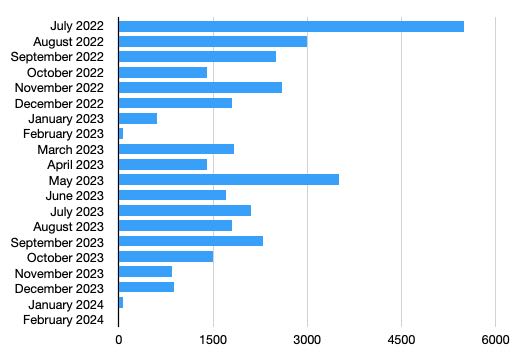
| An approximation of the monthly totals recorded in the text up to 22nd February 2024.
Unlike fleabane, onion weeds live more than one year, growing bigger each year. In the later months I had removed almost all plants a year or more old in 'my' areas and those I was removing were mostly small seedling.
| |
- 2nd January 2024 (Onion weed progress continued), scattered plants, N end BSPS
- 6th, 2 in BSPS after walking right around
- 11th, 15 or so NW boundary area of BSPS
- 20th, about 20, BSPS
- 1st February 2024, only 2 found N end and E side BSPS
- 4th, half a dozen at foot of retaining wall parallel to Flinders Street, Novara beach area
- 17th, 2 from path around BSPS
- 26th, 1, east side BSPS
- 4th March 2024, 12, around BSPS, outer area
- 30th, Three dug out west of Novara boat ramp. There remain at least 100 at base of the wall SE of Flinders Street.
- 31st, about 300 at base of wall SE of Flinders Street.
- 6th April 2024 (onion weed progress continued) I went right around BSPS, about 12 found and dug out
Also see the section on onion weed, fleabane and progress with the control of fleabane on this page.
| |
Dune onion weed starting to flower
|
|---|
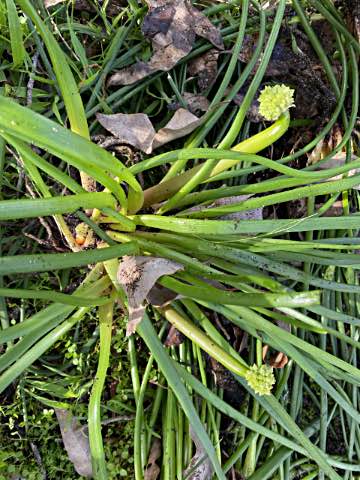
| Northern end of big swamp, 2022/07/15.
| |
As shown in the photo on the right, at this time (mid July 2022) the onion weed was getting ready to flower and set seed. Many plants will set seed; I can't hoe them all out in time to stop that, but there will be over 6000 plants less setting seed than there would have been had I not worked at eradication.
| |
|
Young Trachyandra divaricata plants have a distinctive feel, their leaves have a particular type of sandpapery roughness that distinguishes them from plants that might look superficially similar. And the young leaves are round in cross section, more mature leaves are flat and have a smooth feel.
|
|
'True' onion weed, Asphodelus fistulosus, is probably more correctly called onion weed than is T. divaricata. It is a major weed in the Flinders Ranges of South Australia. Advanced T. divaricata has fairly flat leaves that are sappy inside (juvenile plants have round leaves), A. Fistulosus has round hollow leaves. Asphodelus fistulosus does not seem to occur in the Erskine area where I've been working.
Young grass tree, Xanthorrhoea, plants (commonly called yaccas in the eastern states) could be mistaken for onion weed. Xanthorrhoea have hard angular leaves rather than the soft strappy dune onion weed leaves and they lack the sandpapery roughness of young onion weed leaves. Xanthorrhoea are native plants and should certainly not be destroyed.
Rushes have round stems that could be mistaken for the leaves of dune onion weed, but they are more rigid and harder; again, unlike young onion weed leaves, rushes have a smooth feel. Dune onion weed leaves are softer and more fleshy than rush stems. Rushes seem to grow in areas more inclined to water-logging than where onion weed generally grows.
Nut grass (or what I call nut grass, it grows locally and back in SA too) has a thin single stem, very tough and fibrous (could be used to make string?) and a bulb at the base. It can be mistaken for the first single stem of a seedling onion weed but is wiry rather than sappy.
| |
Dune onion weed in the northern end of BSPS
|
|---|
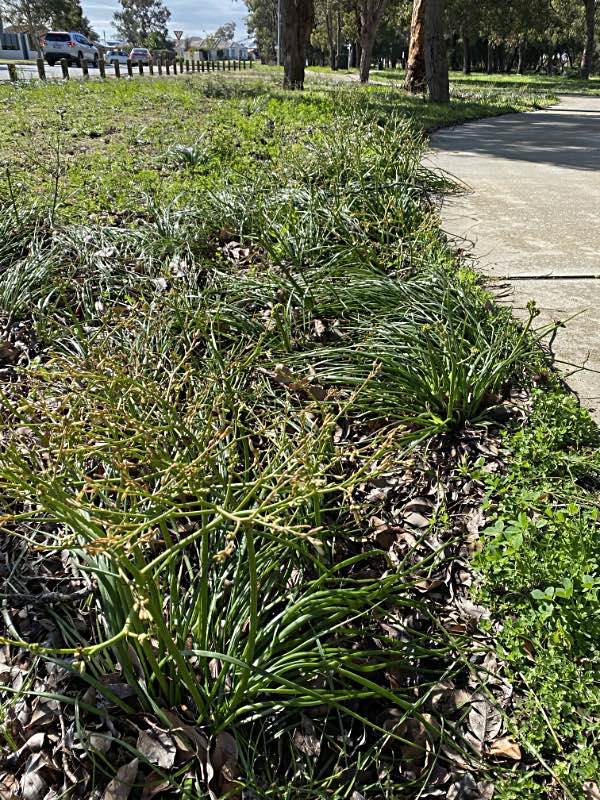
| Photo iPhone 11 Pro, standard lens, 2022/08/18
| |
The photo on the right shows dune onion weed plants at the northern end of the BSPS that were going to seed at the time, 2022/08/18.
I had been told by a council employee that council would spray these plants with an appropriate weedicide, but as they were going to seed and had not been sprayed I decided that I needed to hoe them out before they could set seed.
Once they had flowered it would be possible for them to set seed even if they were hoed out.
I didn't manage to get them all out before they went to seed.
| |
This section added
2022/06/21
|
|
| |
The 'Big seasonal paperbark swamp', BSPS
|
|---|

| This Google Earth image, dated 2018/11/14, shows water in two places in the swamp. Most times of a typical year there is no surface water present. The Bridgewater Lifestyle Village is beyond the first row of houses on the left of the image.
The inner part of the BSPS is the responsibility of the Parks and Wildlife Service, while the outer more open parts, are council responsibility. |
| |
| |
First planting in the BSPS
|
|---|
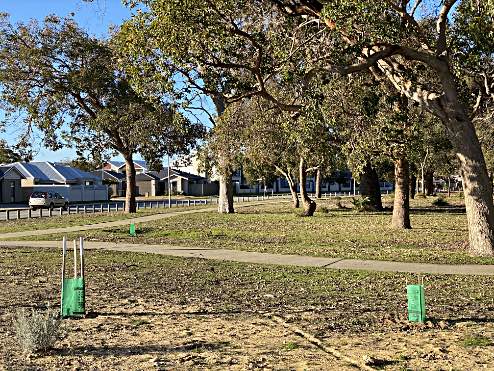
| Note the 'plastic bag' tree guards
| |
This area, of about 20 hectares, which should but doesn't seem to have a formal name, is on the NE side of the Bridgewater Lifestyle Village and adjacent to and north of the Len Howard Conservation Park. I note that according to the Parks and Wildlife this is not a part of the Len Howard Conservation Park.
This area, the name of which I have abbreviated to BSPS on this page, had certainly taken up most of my time and effort in weed control in the second half of 2022. It was far more seriously infested with fleabane than I at first realised; and onion weed had a strong hold in parts, particularly the northern end.
In several places there are big gaps between the gum trees in the reserve surrounding this swamp. Bare areas attract weeds, and both fleabane and onion weed had invaded these areas; I have worked at removing these two weed species in this area and elsewhere in the vicinity.
About 2022/06/18 I contacted Mandurah Council asking their opinion on my planting some attractive trees in these areas. I feel it would both discourage weeds and make the area more attractive. By 2022/07/08 I had not received a reply so I contacted them again again asking about planting and informing them again about my efforts to remove fleabane and onion weed. I eventually received a reply stating that the area was not Council's responsibility, it was that of the WA Planning Commission, so I contacted them in early July (by the end of July I had not received a reply). I have been told since that the more outer parts of the swamp area are Council's responsibility, the inner part is the responsibility of the Parks and Wildlife Service.
I have placed bamboo stakes with flagging tape adjacent to plants that could be slashed by whoever does the seasonal weed slashing.
I've flagged not only the seedlings I've planted but also the smaller Xanthorrhoeas and zamia palms (Macrozamia riedlei).
After getting permission to plant marri trees from Council in their section of the park, and after they paid for ten seedlings from Men of the Trees I started planting with the first four seedlings on 2023/07/02 using stakes and 'bags' previously supplied by Council. (I had planted many thousands of trees in SA before coming to WA, see for example my piece on my own property, Elysium, in the Clare Valley.)
I planted another four marris on 2023/07/05, N end BSPS and five on the following day.
How hard the numerous kangaroos would be on any trees that I might plant is an open question, but my experience with planting in the Wattleglen/Silverton reserve suggested that gum tree seedlings were not very attractive as kangaroo food. Time will tell.
| |
Wire tree guard
|
|---|

|
| |
| |
Responsible authorities for the BSPS
|
|---|
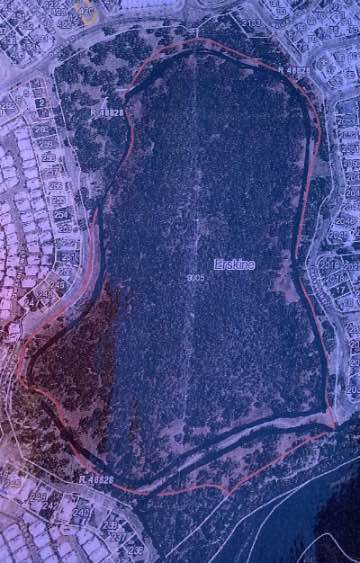
| |
After receiving many warnings that the kangaroos will be very hard on any trees I plant in the BSPS I replaced eight of the ' plastic bag' tree guards with wire mesh guards like the one in the photo on the right on 2023/07/09.
But then I was told that Council disallow wire mesh tree guards because they are "a hazard to the mower" (which I can sympathise with). So I took out the wire guards and replaced the 'plastic bag' guards.
On 2023/07/14 I was informed of the Council's Parks Team's guidelines (after I had done the planting):
"Plant the trees in an area with no canopy cover and at least 10m away from any other tree to ensure best chance of survival. Ensure they are not planted within 10m of any hardscaped areas to ensure they are not damaged by root growth."
So some of the seedlings had to be moved.
Council planted 13 or so large Eucalypts a week or two after mine had been moved. I noticed that two were six metres from a path and one three metres.
I have been informed by a Council employee that the area inside of the black line in the map on the right is Parks and Wildlife responsibility and that the area outside that line is Mandurah Council responsibility.
It was the parts of the BSPS that are Council's responsibility that had by far the worst infestations of false onion weed in any of the areas that I have worked on.
Early in 2023 I scattered seeds of a local Acacia saligna and some Hardenbergia comptoniana while digging weeds. Both lots of seeds were collected from plants in the LHCP.
On 2022/08/08 I was told by an employee of the City of Mandurah that a condition of the development of the Bridgewater Lifestyle Village was that the swamp area had to be kept in its natural state as a reserve. Both areas were owned by the same people,
| |
Tall fleabane plant
|
|---|

| Around the outside of the BSPS the plants are slashed periodically. Further into the swamp area no slashing is done. This is one of taller of the hundreds of fleabane plants I came across in the reserve area out of sight of the perimeter path. I placed it against my bike for scale.
| |
| |
This section added
2022/07/24
|
|
About mid July I was hoeing out onion weeds in the big seasonal paperbark swamp adjacent to one of the paved trails, when a man stopped and asked: "Why are you doing that?" as if my purpose was unimaginable to him. Was he unusual or would it be so incomprehensible to many that a person would want to remove weeds from a conservation park?
2022/07/24, another man stopped and said: "I've got to ask, why are you doing that?" I said something like "I'm digging out weeds; they have no place in a public park." Several other possible answers came to mind after I had thought about it for a while:
- Would you dig a weed out of your garden? Why then not out of a public park?
- Do you not care about weeds in your public places?
- I dig weeds out of my garden, why should I care less about weeds in a public park?
- If I am unwilling to try to improve our public places, why should anyone else?
- If no one cares for our parks what will become of them?
- If you have to ask you will probably not understand my answer.
- This is a beautiful park which the people of Mandurah are very lucky to have. Removing the most conspicuous, unsightly and invasive weeds can only improve it.
Is caring for our shared environment such an uncommon thing to do?
My page on contribution covers the point in depth. My notes on self or all and the rights and needs of future generations are also relevant.
There are many species of introduced plants in the areas where I am working. Of course it is quite impossible for me to remove them all. But I hope I can remove the more conspicuous, problematic, unsightly and invasive species.
Several Lantana plants are growing in Len Howard CP. They should be removed, but I have not attacked them as of February 2023.
Evening Primrose, plants of the genus Oenothera, are well established between the shared use path and Len Howard Drive along much of the western end of Len Howard CP. I have made no attempt to remove them because they have attractive flowers for several months of the year and they do not seem to be invading the conservation park.
| |
This section added
2022/11/03
|
|
| |
Mandurah Council
Before I had identified the weed myself I took a specimen to Council headquarters hoping to get it identified. There was no one there who could help me. I was told that there could be someone at the depot but that the depot was not open to the public.
I submitted a report and inquiry to council giving the location of the first patch of cockspur that I found. I hadn't received a reply by 2022/11/10 so I know nothing about Council's policy regarding Maltese cockspur.
|
|
There is a bad outbreak of this weed ( Centaurea melitensis) - close to the path, not in the adjacent bush - in the Len Howard Conservation Park adjacent to Glendart Court. There are also quite a few plants in the northern end of the BSPS, near Oakleigh Drive.
It feels sticky and leaves an unpleasant bitter substance on the hand.
For more information on this weed see the Florabase WA page.
Control work...
- November 3rd, pulled cockspur from a four metre section of the path;
- 4th, about 60 pulled out from adjacent the path on Glendart Court and others pulled out of BSPS, north end;
- About 20 plants pulled/dug out NW corner of BSPS;
Later I realised that this weed is quite widespread adjacent to paths through the Erskine area.
I've given it a lower priority than Onion weed and fleabane.
| |
This section added
2023/01/20
|
|
I've come across a half dozen or so of these plants scattered around in the northern part of the BSPS.
It is a poisonous native of parts of Southern Africa and considered to be an invasive species in Australia and a number of other places. It is also very prickly, a nasty plant all around!
Common names include devil's apple and apple of Sodom. See Wikipedia.
Photo iPhone 11 Pro, 4.25mm (standard) lens, 2022/12/21
I partly dug, partly pulled, a big plant out in the southern end of the BSPS on 2023/11/15. It was about 800mm tall.
| |
Black nightshade, Solanum nigrum
|
|---|
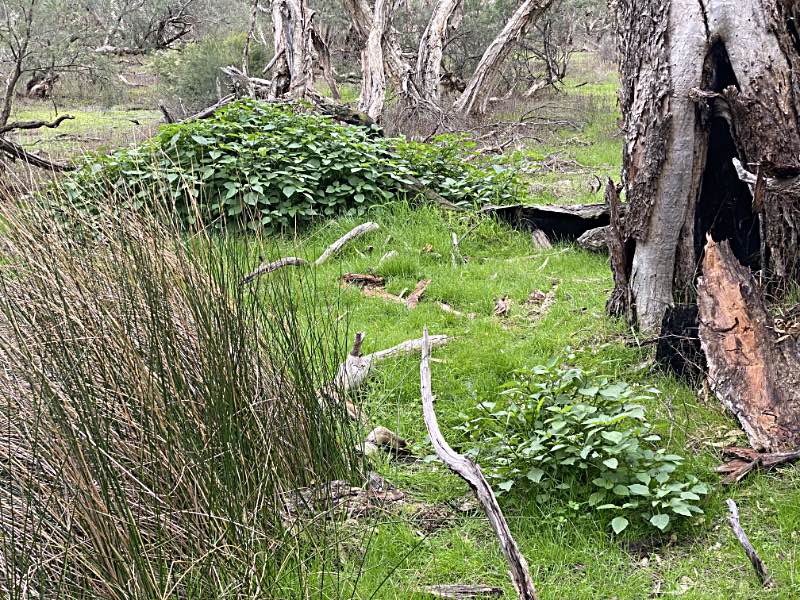
| By far the biggest number of black nightshade plants that I had found in the area to this time. These two clumps of 50 or more plants were at the edge of the paperbark forest at the south end of the BSPS, very close to the area that is seasonally flooded. The plants on the left are native rushes.
Photo, 2023/07/18, iPhone 11 Pro, telephoto lens, 6mm fl.
I found and pulled out several dozen more plants in the same area over the following weeks. | |
This weed occurs widely around the area but usually only as individual plants or two or three plants close together. It is generally easily pulled out with all its roots. I pull it out whenever I notice it.
For more information see Wikipedia. Quoting from the Wikipedia article:
“Sometimes S. nigrum is confused for the more toxic deadly nightshade (Atropa belladonna), which is in a different genus within Solanaceae. A comparison of the fruit shows that the black nightshade berries grow in bunches, whereas the deadly nightshade berries grow individually. Another distinction is black nightshade flowers have white petals.”
On the flowers of deadly nightshade Wikipedia states: "The bell-shaped flowers are dull purple tinged yellow-green toward the base".
| |
This section added
2023/01/11
|
|
Caltrop is a well established weed in South Australia where I lived before moving to Mandurah. After almost a year in Mandurah the outbreak photographed here is the first I've seen in the area.
Caltrop thoroughly deserves the alternative common name of puncturevine because it is deadly on bicycle tires (also on dog's feet and children's feet).
The image on the right (click on it to see it in higher definition) shows two mature caltrop plants. The photo below shows a pair of the spiked seeds in close-up. It has a small yellow flower with five petals.
I hoed out more than twenty plants in the strip between the road and the concrete shared-use path in front of the vacant lot at 70 Silverton Crescent in Erskine on 11th January 2023. While I removed all I saw you can be sure that seeds would have been left behind. To get to the stage of this infestation would have taken several years.
On the right is a close-up of a part of one of the plants with two of the viciously spiked seeds left of centre.
I'd urge everyone to look out for this plant and remove it when they see it. People near 70 Silverton Crescent, where these plants were found, would do well to be especially vigilant.
The area around Silverton Crescent, Erskine is very popular for cycling. Cyclists would do well to also keep an eye out for caltrop and remove any plants they see.
Caltrop is an annual plant introduced to Australia from southern Eurasia and Africa. It germinates following any summer rain and can grow in soil so dry that little else grows.
Caltrop is a vicious weed that can be controlled with persistence and not a lot of effort.
I wrote a letter on this to the Coastal Times and Mandurah Mail. It was published by the Times in their 2023/01/18 edition, although without the photos and the street number.
Apart from the outbreak mentioned above:
- I had pulled out some caltrop plants on the path adjacent to Len Howard CP;
- March 2023 On 2023/03/06 I pulled out and removed about 30 plants from the edge of the road adjacent to the WOGL reserve
- On March 14th I hoed out a half dozen plants, some of them very big, on roadside adjacent the SWS
- March 31st, about 10 big plants WOGL reserve, North corner
- April 1st, about 15, WOGL reserve, North corner
- 4th, about 20 pulled out in front of a vacant block near the eastern end of Silverton Crescent.
- 12th, probably in excess of a thousand seedlings, and a few larger, sprayed on roadside adjacent SWS
On 2023/12/14 I dug out feral rocket ( Diplotaxis species) and Weasel's snout ( Misopates orontium) from the W/S reserve.
| |
|
|
|---|

|
Photo iPhone 11 Pro, 2023/12/19, standard lense, 4.25mm fl
Novara Foreshore Reserve
| |
On 2023/12/19 I pulled out about 30 sea spurge ( Euphorbia paralias) plants from Novara Foreshore Reserve. While this weed is common on the ocean coast in the Mandurah area, it is less common on the Peel lagoon coast. I pulled out all the plants that I saw. There are many sea spurge plants in the many little artificial bays area just east of Mandurah Quay.
Also on 2023/12/19 I pulled out 30 or so prickly lettuce (Lactuca serriola) from the same area. Prickly lettuce is widespread in the area, I pull it out at times, but give it a very low priority.
Both the prickly lettuce and the sea spurge was among boulders that had been placed to protect the shore from wave erosion.
| |
This section added
2022/07/13
|
|
| |
|
|
|---|
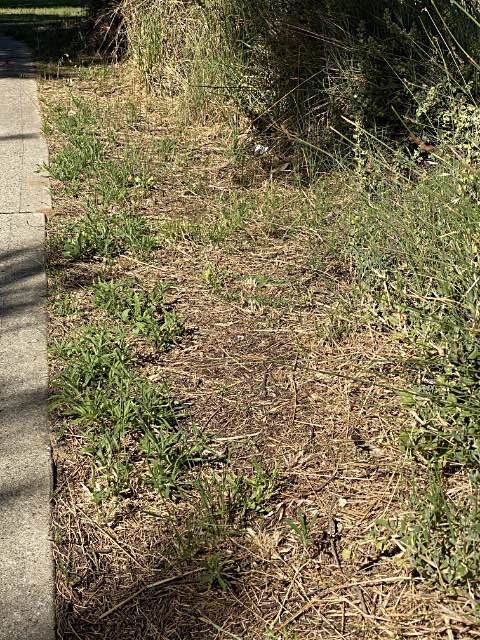
| Photo taken 2022/12/12. See text on the left.
The fleabane was still there in mid February, but much taller. | |
Any council has a difficult job to do. There are always people who want more done by their council, but who wants to pay higher rates for more services? On the whole I think Mandurah Council does quite well.
The ordinary people could do far more for their communities, but, in Australia at least, in my experience, the great majority don't feel any obligation to do work they might see as council's responsibility. Similarly, most people don't want to do anything for parks that might come under the jurisdiction of state or federal government.
An example of Council's difficult balancing act
| |
This section added
2022/12/12
|
|
The photo on the right shows an area where somebody, presumably Council, had bared the ground by removing the natural rushes and other native plants beside the path, probably because there are snakes in the area. Most of the plants on the left of the image are fleabane that has taken advantage of the bare ground and colonised it, as might have been anticipated.
Ironically there was a sign less than a 100m away saying that there had been damage to native plants in the area and that a $1,000 fine applied to anyone damaging native vegetation. Will Council fine themselves?
Or have I done Council an injustice, and was the ground bared by some individual who was intending to do good without realising the consequences of his actions?
I informed council and asked whether they, or someone else, had done the clearing. Someone came out to look at this infestation about 23rd. I went back on 30th. It seems that nothing had been done. They didn't tell me whether the clearing had been done by council.
| |
Posts to stop vehicle access to Big Seasonal Paperbark Swamp. Not a lot of use when there is an obvious entry point; see below.
|
|---|
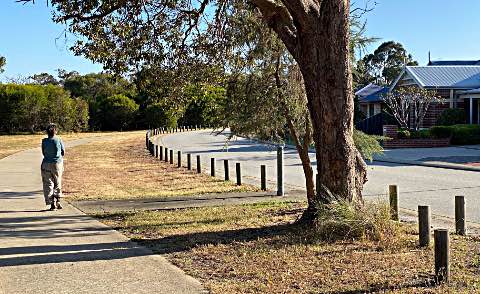
| I estimated that there must be about a thousand posts like these around the BSPS. They are about 1.5m apart and the perimeter that is adjacent to public roads is about 1.6km long.
|
| |
| |
Ground plowed up by yobbos
|
|---|

| With all those posts to stop vehicular access you'd have to wonder how the yobbos got in.
|
| |
| |
Easy vehicle access here
|
|---|

|
Why is this place left open for yobbos to get access to the park? This gap and a very few others make the thousand posts blocking access elsewhere useless.
The three photos above were taken 2022/11/26.
Council were informed that day. There had been no action to fix the situation by mid 2023, nor had I had any response from Council.
| |
On 2022/08/01 I was very surprised to be reprimanded for hoeing out onion weeds by a ranger employed of the City of Mandurah. After some conversation I asked her "Does council like having weeds in their parks?" She replied "I didn't say that". Among other foolish things she said to me was: "Digging out anything from a national park, whether it’s a weed or not, is damaging the park.” How bizarre!
While she demanded my name she refused to give her full name. I wonder what sort of education the City of Mandurah demand of its rangers, because she didn't know what onion weed was, in spite of it being a very common and invasive weed in some Mandurah parks. She also accused me of digging out trees, a completely baseless accusation.
Council approves my work removing weeds
On 2022/08/08 I met two council employees at the Big Seasonal Paperbark Swamp (BSPS). They told me that it was quite OK for me to go on with what I had been doing, contrary to what the ranger had said.
I have been disappointed in that while I have removed tens of thousands of onion weeds and fleabane plants from Council land they made me remove some pig-face ( Carpobrotus) plants that I had planted along a hundred metres of path near my home. I would have thought that a bit of give-and-take would be reasonable.
Council's page on environmental weeds
Mandurah council has a page titled 'City of Mandurah Environmental Weeds'. This page details 13 weeds, but curiously does not mention fleabane or onion weed, which in my experience are the most invasive weeds of the local public places. Nor does it mention either of the Solanum species I've noted, or Centaurea melitensis (Maltese cockspur) and Euphorbia paralias (Sea spurge).
Unlike the Mandurah City Ranger's reprimanding me for removing onion weed ( above), as mentioned in the section on progress on onion weed (18th July), the Parks and Wildlife Service people I spoke to were very happy to have me removing onion weed and fleabane from the Len Howard Conservation Park.
| |
This section added
2024/01/11
|
|
Bridgewater Lifestyle Village (BLV) borders on the Len Howard Conservation Park; specifically, the Village's eastern boundary abuts the western side of the Big Seasonal Paperbark Swamp (BSPS).
On 2024/01/11, while removing fleabane from the western border of the BSPS, I noticed that there was a bad infestation of fleabane on over a hundred metres of the road verge adjacent to the recreation area of the village.
If this infestation is not controlled it will set seed that will blow into the BSPS. There are, of course, many places where fleabane is growing in the front of houses etcetera, but this would be by far the biggest infestation close to any area that I am working on.
On 2024/01/11 I emailed Tracy Cary of National Lifestyle Villages, apparently the parent body for the BLV, and requested that they destroy the fleabane along their boundary against the BSPS. After I had not received a reply by 2024/01/16 when I went to the administration office of the Village and requested action there too.
On 2024/01/22 I received a reply from Ms Cary who apologised for her delayed response saying that she had been on annual leave. She further stated "We have recently sprayed the area and will continue to do so in every effort to get rid of the weeds on our verge. Our maintenance gardening crew are very much aware and are trying to get back on top of things after a change of staff."
I've also requested help on this infestation from Mandurah Council.
| |
This section added
2024/01/11
|
|
I added this section to this page on 2022/12/04 after a person alleged to me that glyphosate is a terrible toxic substance. I don't know where she got her information from, but she was quite wrong.
Glyphosate toxicity; information from authoritative sources:
USA Environmental Protection Agency:
- "No risks of concern to human health from current uses of glyphosate;
- No indication that children are more sensitive to glyphosate;
- No evidence that glyphosate causes cancer in humans;
- No indication that glyphosate is an endocrine disruptor."
Australian Pesticides and Veterinary Medicines Authority (APVMA);
“The current assessment by the APVMA is that products containing glyphosate are safe to use according to the label instructions.”
National Library of Medicine, PubMed Central. Glyphosate toxicity and carcinogenicity: a review of the scientific basis of the European Union assessment and its differences with IARC (International Agency for Research on Cancer).
Elsevier Science Direct; Exposure risk and environmental impacts of glyphosate: Highlights on the toxicity of herbicide co-formulants. It seems that the authors consider the adjuvants in the various formulations are of just as much, or more, concern than the glyphosate itself.
| |
This section added
2023/01/28
|
|
I have never seen any evidence of kangaroos having browsed fleabane plants in the Erskine area. So I was surprised to notice that in Caversham wildlife park walk-through kangaroo enclosure the only fleabane plants were where the kangaroos couldn't get to them. This strongly suggested that the kangaroos there ate fleabane when they could get access to it.
I couldn't find anything definite on the Web other than some references to at least some fleabane species being mildly toxic to some animals.
| |
This section added
2022/08/01
|
|
The following letter was sent to the Mandurah Mail newspaper 2022/07/16 and published the following week.
“Some people will have noticed an old man (me) digging out onion weeds or pulling out fleabane from parks and paths around Erskine. And they might wonder why he does it.
I’m new to Mandurah, only lived here since February. Back in SA I used to spend a fair bit of my time looking after some parks, planting trees and picking up roadside rubbish. Strange pastimes you may think.
But a bloke needs something to do, and games like bowls and golf have always seemed to me pointless. Why not use your time and energy doing something that will improve your local environment? My web page https://comagecontra.net/Australia/Fleabane.html will give you more information.”
I've had some odd comments while I've been working.
| |
This section added
2023/03/26
|
|
I have aimed at:
- Working in important areas - areas of high conservation value;
- Working within a reasonable distance of my home;
- Removing the most invasive weeds;
- Removing the most unsightly weeds;
- Removing weed species that I am likely to be able to locally eradicate;
- Preferentially removing weeds where they are in manageable numbers, cleaning up the lighter infestations first;
- Giving higher priority to areas most frequented by walkers.
I have weeded in Osprey Waters Foreshore and Novara Beach Reserves because, while they are a relatively long way from my home, the limited numbers of weeds were easy to control.
I have not weeded in the part of Len Howard Reserve east of the BSPS because it is a considerable distance from my home and there is a high level of weed infestation. I have not weeded on the north side of the Old Coast Road because of the heavy traffic and difficulty in crossing the road. (Lilac Park, an attractive little park on the north side of Old Coast Road, is only about a half a kilometre from my home and is infested with a fair amount of fleabane, but as of mid 2023 I have not worked in it).
| |
This section added
2023/06/03
|
|
| |
Diseased Acacia tree
|
|---|
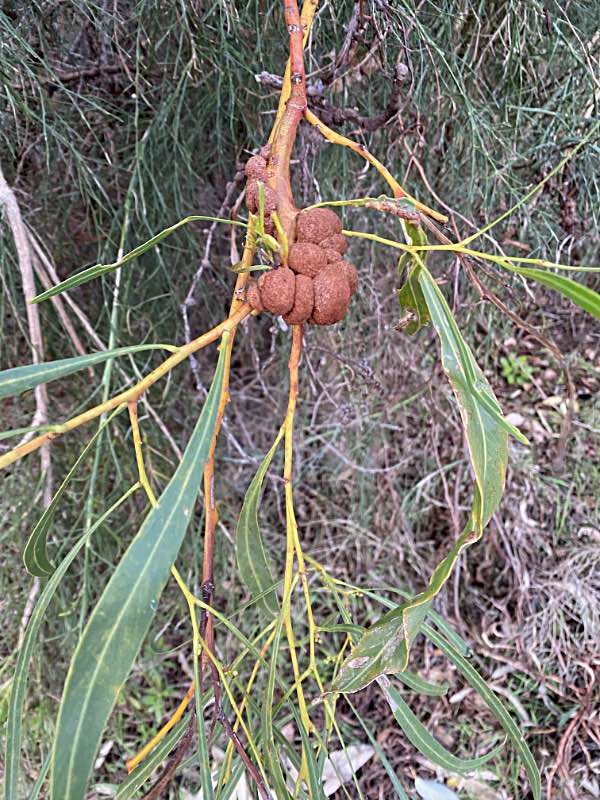
| See text for more information
Photo 2023/06/16, iPhone 11 Pro, standard lens 4.25mm fl.
| |
Since coming to Mandurah, as I notice the need, as the opportunity arises and as time permits I have also:
| |
This section added
2024/01/03
|
|
Then there's Cycling Without Age, Mandurah. I have trained as a pilot and periodically take people for a trishaw ride around the Mandurah waterfront area, free of charge. The aim is mainly to cater for people who are elderly or have difficulty walking. The times are every Monday, Wednesday and Friday between 9.30am and 11.30am.
I'm feeling my age so I don't volunteer on the hotter days, of which there are many in summer. As of the time of writing (beginning of 2024) I have done little piloting. I hope to do much more in Autumn when the weather cools.
Use the link above to make a booking, or just turn up at the Mandurah foreshore near Todd's cafe.
Blood donation
Then there's blood donation; as of early 2024 I'm on record of donating whole blood or plasma 149 times. It would actually be more because the blood service's records only go back a couple or decades or so.
In no particular order: Bowman Park, Gleeson Wetlands, Crystal Brook's Central Park and my campaign to show the facts about wind power in Australia (probably the best thing I've ever done). There are notes on my efforts to be environmentally responsible including installation of 22kW of solar power on various properties. (We were among the first to install solar PV power at Crystal Brook in 2006.)
| |
This section added
2022/04/01
|
|
Most of us like to keep our garden (if we have one) in front of our house (if we have one) looking neat and tidy. But it seems that for most the effort stops there; beyond our front boundary the environment and the aesthetics of the landscape is "someone else's concern, not mine".
| |
You can enjoy your own garden, and passers-by can get some enjoyment from your front garden, but anyone and everyone can get some pleasure from any work you do to improve a public park or garden. So the same amount of work in a public space will lead to more enjoyment than if it was spent in a private garden.
Also see Self or All on another page on this site.
|
|
Why should this be so? Don't we all have an obligation to contribute to the communities in which we live? Shouldn't we all make an effort to make our local community and the world just a little bit better place, within our capabilities? Another thing that we could all do to improve our shared environment is picking up rubbish left by careless others.
As a retiree, living on my investments and superannuation, I feel that I have a responsibility to make a personal contribution to the community in which I live. I have written more about this sort of thing in my About Me page. Apart from local work such as discussed on this page I intend to devote the remainder of my life to trying to get action on climate change, especially in Australia, since my nation has such a shameful record on the matter.
I have written short pieces on Whatever happened to civic pride?, Community spirit and Don't just walk by, do something on other pages.
|
